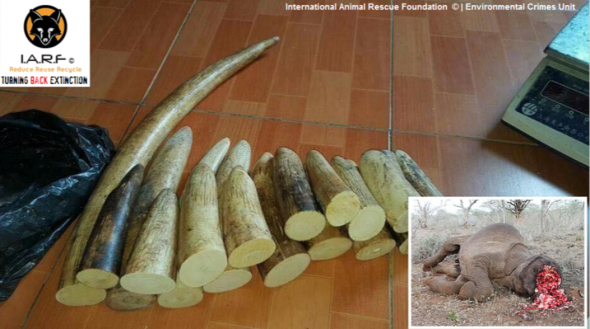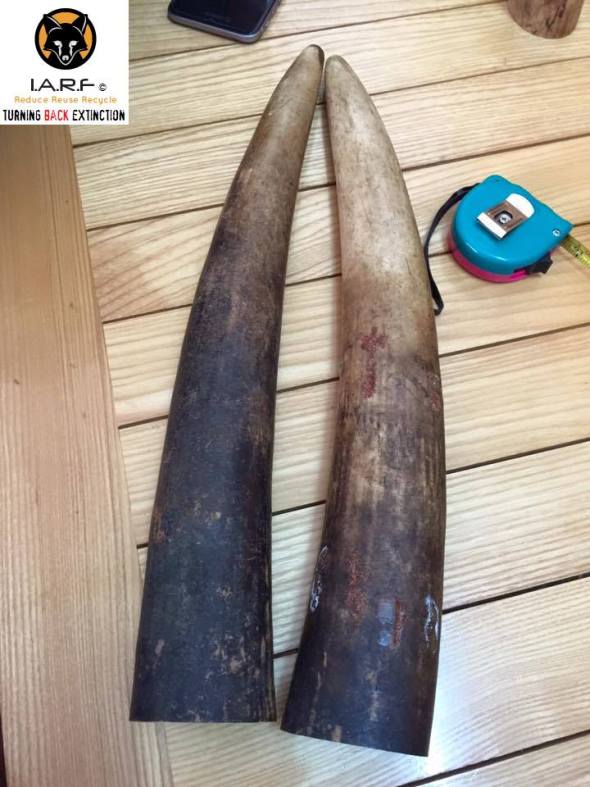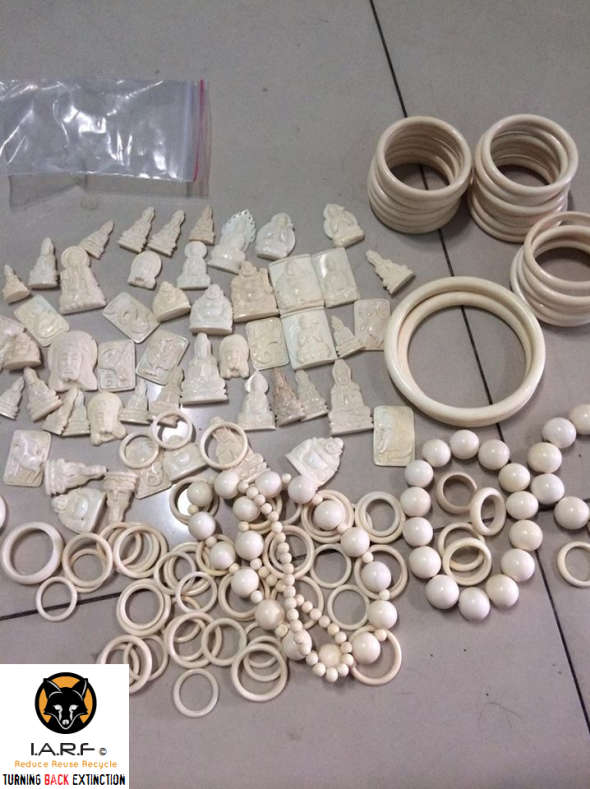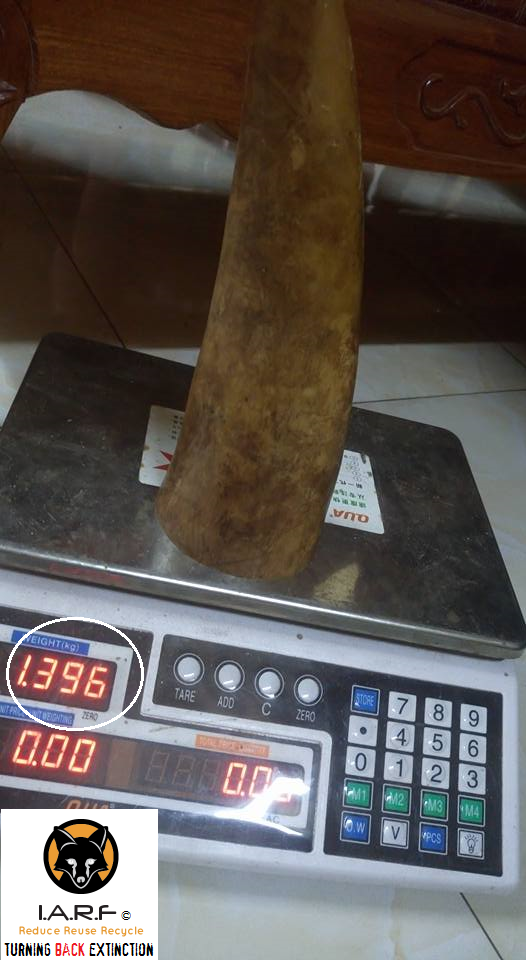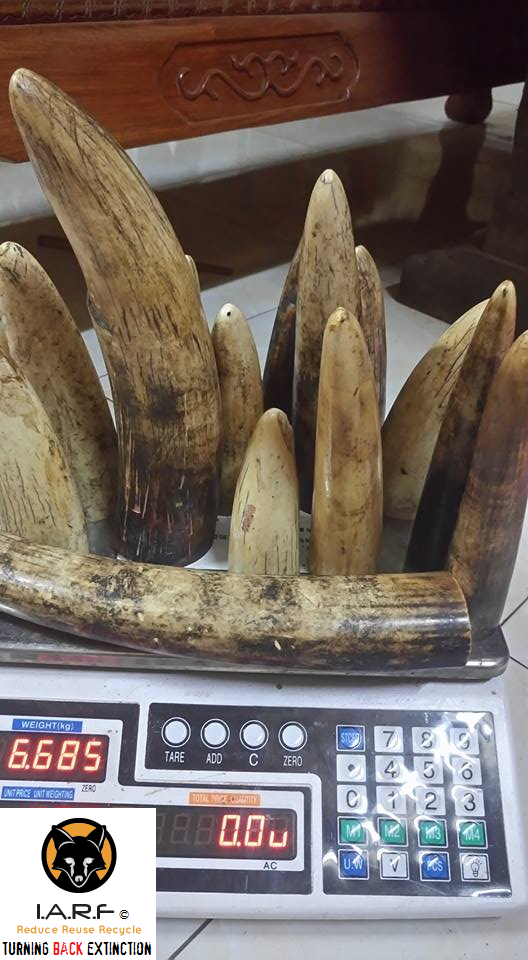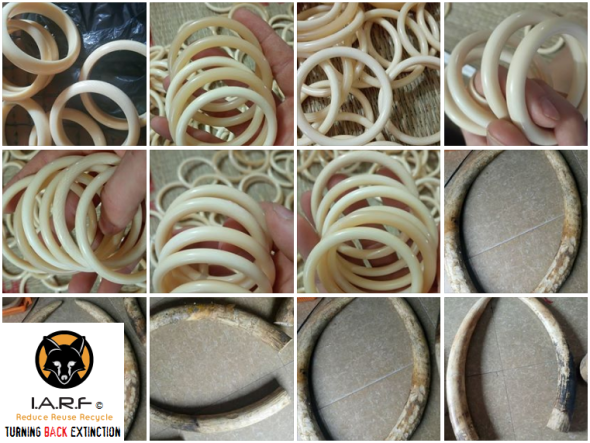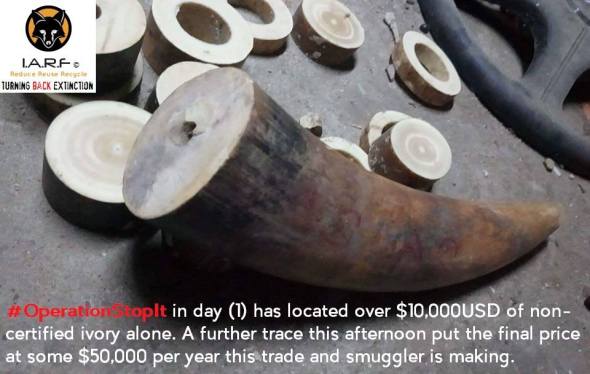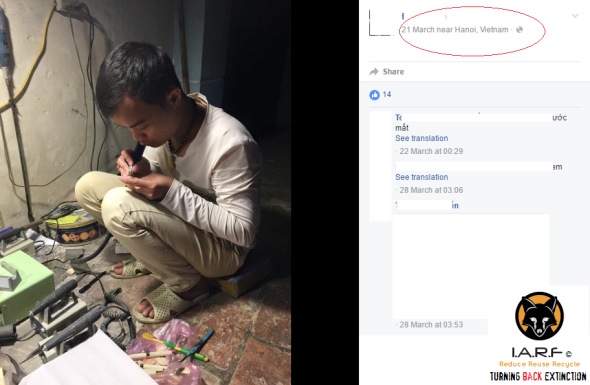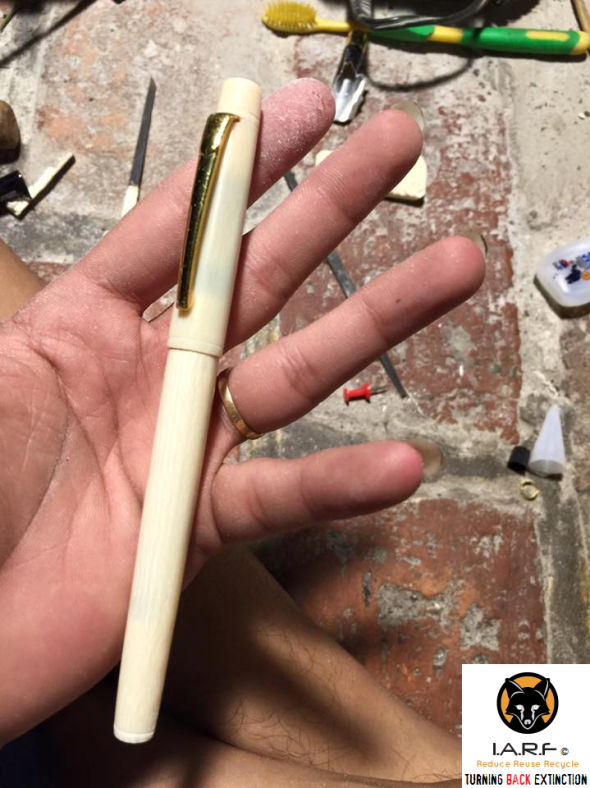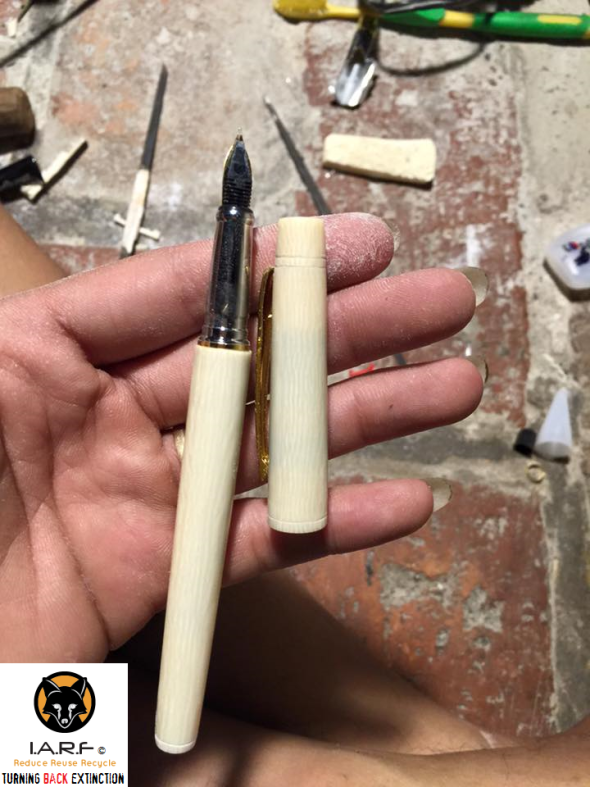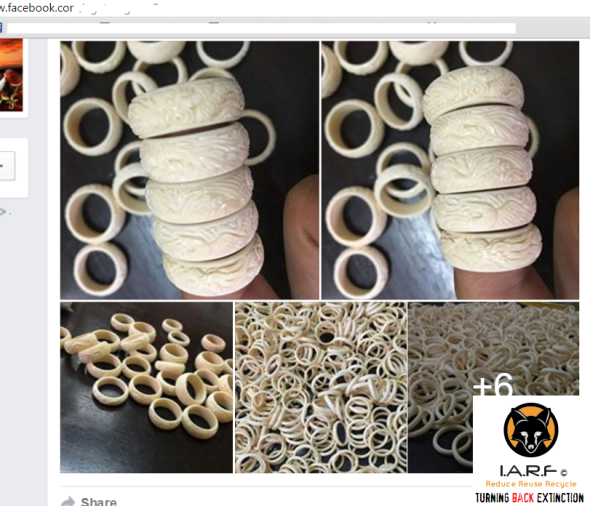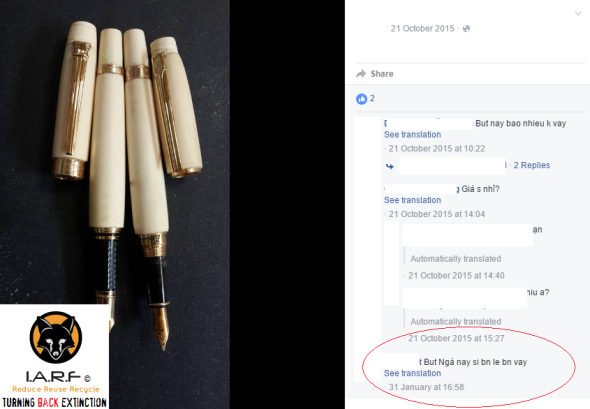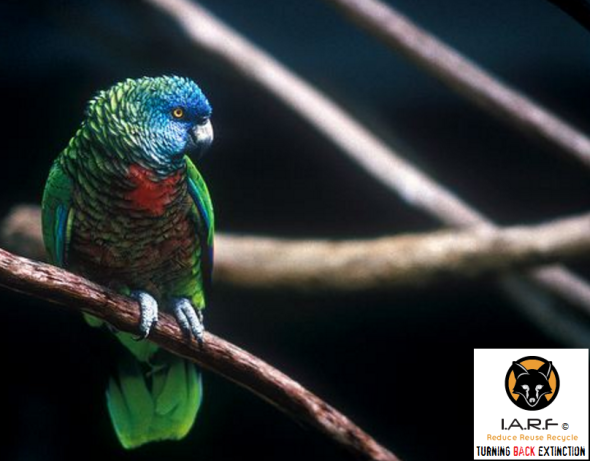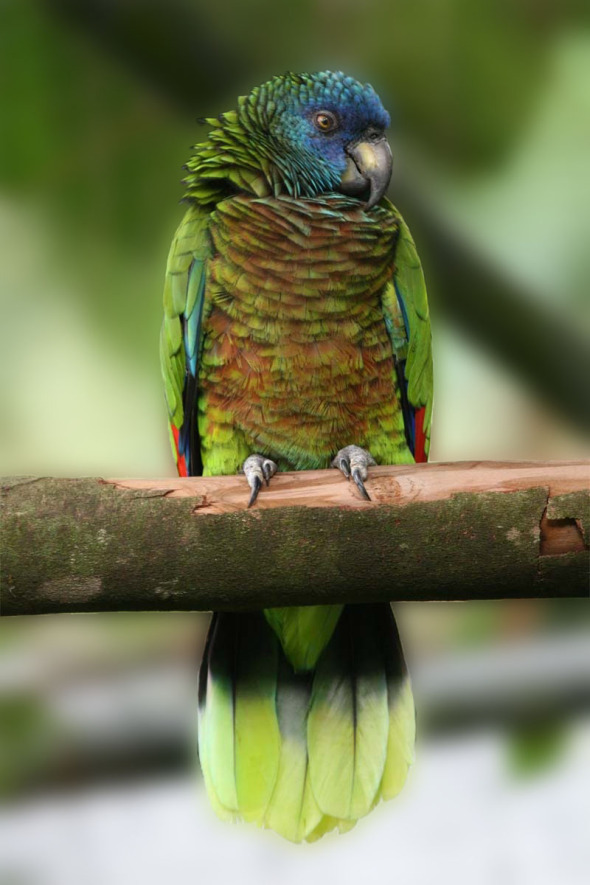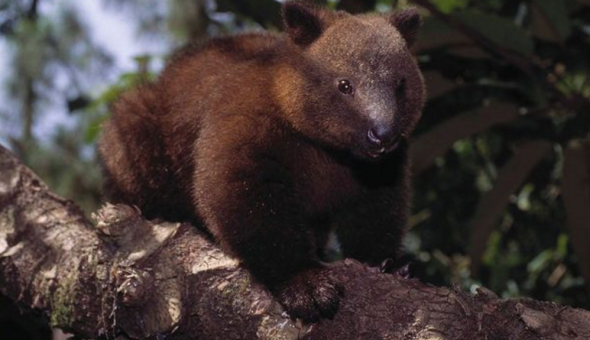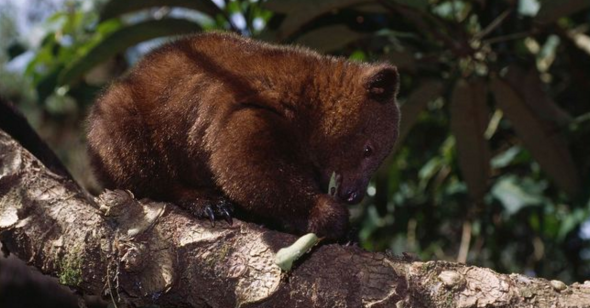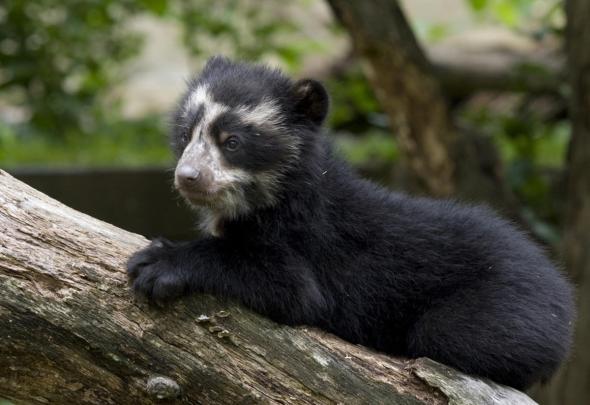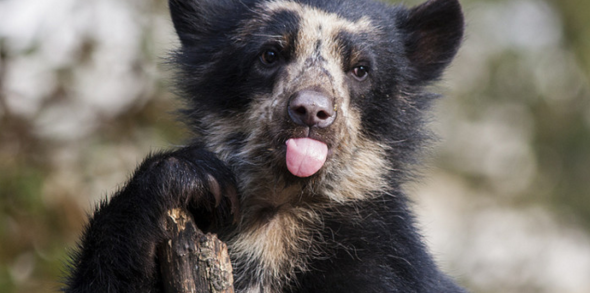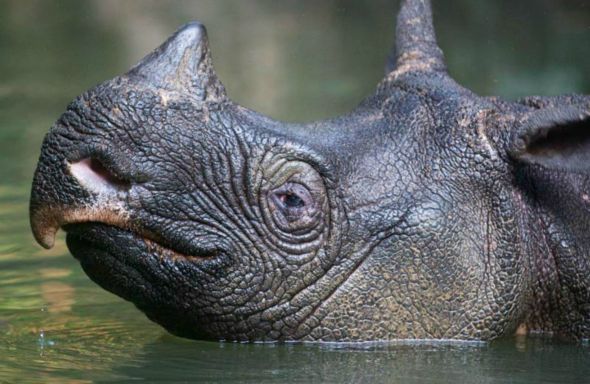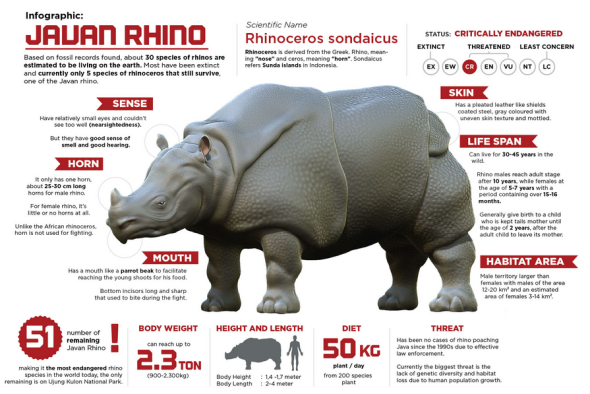ENDANGERED SPECIES MONDAY | SPOTTED SEAHORSE FACING EXTINCTION.
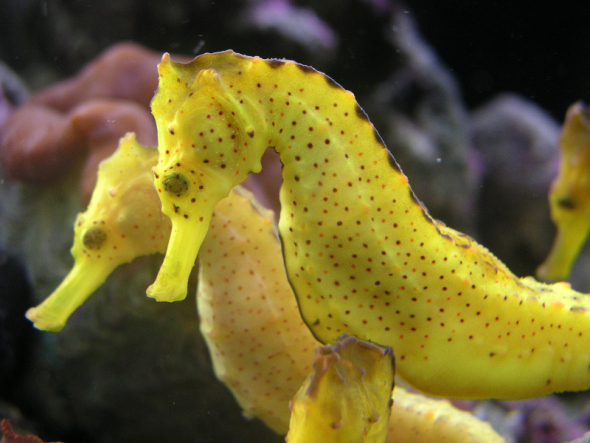
ENDANGERED SPECIES MONDAY | HIPPOCAMPUS KUDA
Once a common site within our oceans, the spotted seahorse (common seahorse) is facing extinction. The largest threat known is use and trade within the Traditional Chinese Medicine culture. As of 2015 its estimated that some twenty million (20 million) seahorses are used within the Traditional Chinese Medicine trade. (Photographer unknown).
Known in Mandarin as Hai Ma seahorses are believed to cure a wide spectrum of ailments and diseases and generally help to improve health. There is no evidence that I can locate to prove seahorses can improve human health in anyway shape or form. T.C.M practitioners have alleged seahorses can cure anything from asthma, arteriosclerosis, incontinence, impotence, insomnia, thyroid disorders, skin ailments, broken bones, heart disease, throat infections, abdominal pain, sores, skin infections.
Broken bones? Now that is about as ridiculous as it gets, impotence and broken bones are not illnesses but more physical complaints of which consuming seahorses is about as effective as pouring boiling hot water onto a third degree burn. A study in Taiwan located some fifty eight (58) sea horses from Taiwanese T.C.M vendors. A total of eight (8) different species were located. Seven (7) were listed as vulnerable, while one (1) was listed as endangered.
Source: http://www.jfda-online.com/article/S1021-9498(13)00043-4/abstract
The species listed as endangered was Hippocampus capensis commonly known as the Knysna seahorse (pictured below). The remaining seven (which doesn’t include the species pictured above) are scientifically identified as Hippocampus algiricus, Hippocampus comes, Hippocampus histrix, Hippocampus kelloggi, Hippocampus kuda, Hippocampus spinosissimus, and Hippocampus trimaculatus. If we include the species above - Hippocampus kuda this makes a total of eight (8) listed as vulnerable, and one (1) listed as endangered equating to nine (9) in total nearing extinction.
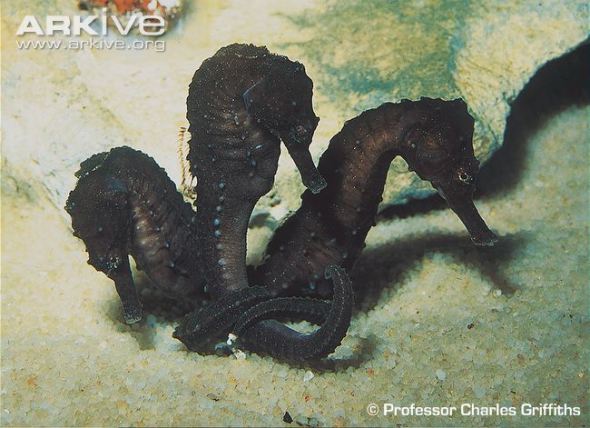
Image: Knysna seahorses | Credits Professor Charles Griffiths
Its quite possible there could be many more species of sea horses that haven’t been listed on the International Union for the Conservation Of Natures Red List [IUCN]. Hippocampus kuda was identified back by Dr Pieter Bleeker (July 10, 1819, Zaandam – January 24, 1878, from The Hague) whom was a Dutch medical doctor, ichthyologist, and herpetologist.
He was famous for the Atlas Ichthyologique des Orientales Neerlandaises, his monumental work on the fishes of East Asia published between 1862 and 1877. I don’t state this often however am going to repeat oneself again. Every single species of animal I’ve written about identified from the (1800’s) has almost all but gone extinct or are at least on their way towards extinction. Another pattern I have found is that many animals and plants used within the (T.C.M) trade were being used thousands of years ago - long before non-Asian travelers identified them. When the species are eventually identified - individual specie populations begin declining!
Since 1996-2003 the common seahorse has been listed as vulnerable, populations are declining very fast, furthermore there was little mentioned about the species at CoP17 in Johannesburg, South Africa; a country that is responsible for a large proportion of seahorse harvests. These harvests are legally shipped from South Africa into Asia, yet large numbers of seahorses are decreasing in South Africa.
I.A.R.F.A Environmental Crime Investigators located one legal trader identified as NGWABE TRADING that hosts a supplying ability of TWO HUNDRED METRIC TONS a month. When we inquired where these seahorses are harvested from, and the species caught we were not given a straightforward answer. NGWABE TRADING was though able to supply us with seahorses that have paperwork (all allegedly legal and above-board.) Yet we’re losing the vast majority of our seahorses. Furthermore I am very suspicious as to whether all of these seahorses are being harvested legally.
Two hundred metric tons per month is no different to two hundred metric tons of sand, cement, or rocks. On questioning the fishing company which I myself do suspect illegal poaching is going on here, many of these seahorses are dry traded to Asia. We’re talking big bucks too. So if this trade was restricted, or even banned, its likely South Africa would lose her seahorses in a matter of years, because legal farming operations wouldn’t be allowed if trade bans came into place. Meaning poaching would increase on a wide scale to supply Asia’s appetite for pseudo medicines.
Source: http://southafrica.tradekey.com/dried-sea-horses.htm
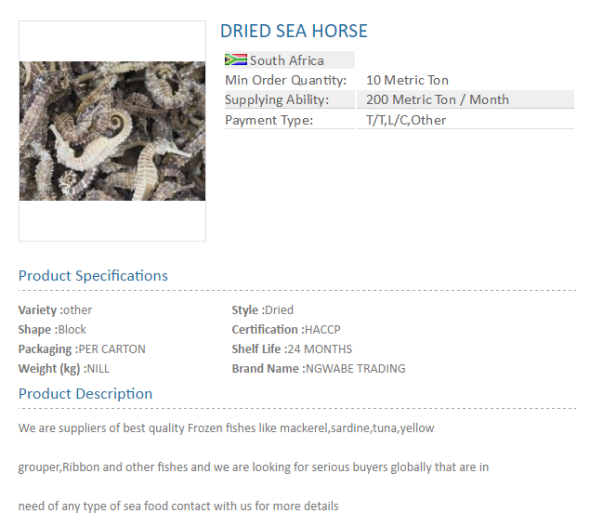
Image: One of many legal online seahorse/fish traders trading to Asia.
Seahorses are also used as an aphrodisiac and to facilitate childbirth in the T.C.M trade. As much as I want to disbelieve this, there is unfortunately “some scientific evidence” that does prove to a degree consuming a regular fish diet can improve sexual behavior within humans; however helping to conceive I am somewhat skeptical about. Sources are cited below for your information from the scientific community.
Source 1: http://www.pbs.org/wgbh/nova/seahorse/vincent.html
Source 2: http://www.acupuncturetoday.com/herbcentral/sea_horse.php
Between twenty (20) and forty (40) million seahorses are allegedly harvested every-year for the T.C.M trade, however if we go on the amount of trade originating from South Africa - its obvious that by the ton load this number is seriously under-quoted. If I myself was purchasing the minimum ton load of ten (10) tons per month - that would easily equate to over twenty (20) and forty (40) million seahorses per annum based on twelve (12) months.
So I think its safe to say we’re looking at possibly hundreds of millions rather than the claimed IUCN stats. I must also note that the spotted seahorse is listed on Appendix II, and to date we will never really know how many seahorses remain within their endemic range, or how many are illegally harvested?
The common seahorse in question which is the species harvested the most for the T.C.M trade is endemic to the following regions: American Samoa (American Samoa); Australia (Northern Territory, Queensland); Bahrain; Cambodia; Fiji; French Polynesia; Hong Kong; India; Indonesia; Japan; Kuwait; Malaysia; Micronesia, Federated States of ; Mozambique; New Caledonia; Pakistan; Papua New Guinea; Philippines; Saudi Arabia; Singapore; Solomon Islands; South Africa (KwaZulu-Natal); Taiwan, Province of China; Tanzania, United Republic of; Thailand; Tonga; United States (Hawaiian Is.); and Viet Nam.
Endemic ocean locations are: Indian Ocean – western; Indian Ocean – eastern; Pacific – western central; Pacific – northwest; Pacific – eastern central.
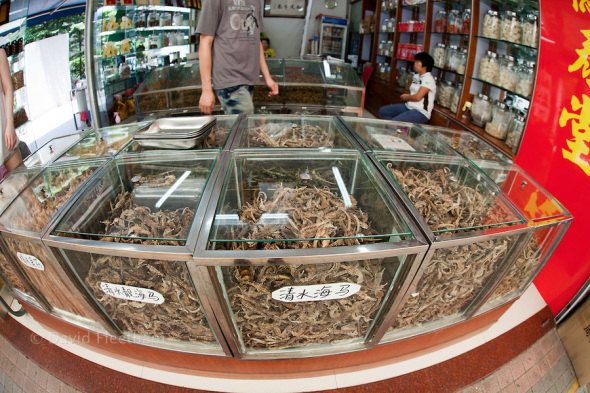
Image: Dried Seahorses for sale, China | Credits David Fleetham
THREATS
Common threats are cited above in more detail. Major threats though are listed below for your immediate attention:
Hippocampus kuda is threatened by damage to its habitats from coastal development and destructive fishing practices. Land-based activities such as coastal construction can diminish seagrass beds and mangroves while leading to increased pollution and siltation in surrounding marine waters. For example, in Malaysia Hippocampus kuda numbers declined due to an extensive port development around the Pulai Estuary that destroyed large tracts of seagrass meadow.
Fishing methods such as trawling result in substantial damage to seagrass beds globally, and especially in the Indo-Pacific. The decline in and fragmentation of the species’ habitats throughout its range indicates possible declines in populations in addition to those caused by fisheries.
All seahorse species have vital parental care, and many species studied to date have high site fidelity, highly structured social behaviour, and relatively sparse distributions. These life history parameters often make species susceptible to exploitation as has been demonstrated for a number of species, including seahorses. Although seahorses also have some traits, such as small body size, fast growth and high fecundity, that may confer resilience to exploitation pressures.
Due to the mode of spawning exhibited by Hippocampus kuda (ovoviviparous brood pouch male parental care), fecundity is comparatively low compared to non-brood pouch spawning fishes and therefore its capacity for population growth is more limited than other species. As a result of the lack of broadcast spawning of pelagic eggs, dispersal of potential recruits is limited. Additionally, given the limited swimming abilities of seahorses, it is highly unlikely that rescue effects would occur from adjacent populations.
Concluding: I am somewhat concerned about the species future survival. CITES is allowing use and trade however those countries that are listed under the convention are allegedly strictly regulated and monitored - I don’t call ten tons per month from one South African company strict regulation. Countries that are importing/exporting must prove they have permits, however I don’t quite understand how this area of monitoring is working - which it clearly isn’t as the seahorse trade is colossal within many Asian countries and South Africa too.
Hippocampus kuda is listed as vulnerable in the National Red Data Books of Singapore and Thailand, and endangered in the Red Data Book of Viet Nam. In France it is illegal to import seahorses under the name H. kuda.
The future is bleak unfortunately and with trade so fanned out, and from what I have seen on my visits to Asia (increasing) I do honestly believe we’re going to be reporting extinctions in the ‘very near future.’ To date there are thirty two (32) identified species of seahorses. Ecologically, they are important in food chains, consuming tiny fish, small shrimp, and plankton, and being consumed by larger fish (such as tuna and rays) and crabs. So if we lose the seahorse we lose yet another vital source of food for endangered tuna species, rays, crabs, and even whales (Etc.)
Source: http://www.newworldencyclopedia.org/entry/Seahorse
Thank you for reading and please share to create awareness and to improve education.
Dr Jose C. Depre.
Environmental, Botanical & Human Scientist.
www.speakupforthevoiceless.org
SHOULD VIET NAM BE SLAPPED WITH TRADE SANCTIONS? | ILLEGAL WILDLIFE TRADE.
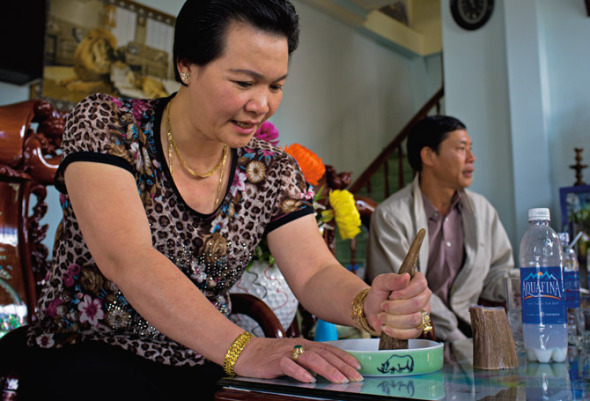
SHOULD VIET NAM BE SLAPPED WITH FULL TRADE SANCTIONS?
Since 2012 International Animal Rescue Foundation Africa’s (Cyber and Environmental Crimes Team) have been investigating Viet Nam’s illicit and illegal wildlife trade more closely than we’ve ever done. Back in January 2015 I Dr Jose C. Depre the (CEO) ordered a meeting with both units from the Environmental Cyber Crimes Team and External Affairs Unit); both focusing on the ground and online trade of illegal wildlife contraband. My aim was to increase both online and ground team investigations to begin breaking the back of these ruthless criminals throughout Asia and Africa.
International Animal Rescue Foundation Africa since founded have conducted 1,033 investigative surveys relating to all areas Viet Nam’s illegal wildlife trade (online and ground trade). However it wasn’t until January 2015 after uncovering a colossal rhino horn trafficking ring within Thailand and Viet Nam that we eventually decided Viet Nam had to be investigated more in-depth - all of which has resulted in a number of arrests and confiscation orders this year alone. The ongoing investigation was ordered due to a suspicion that the illicit ivory trade was increasing in Viet Nam too. Furthermore various organisations, media and press had stated that Viet Nam’s wildlife trade was actually decreasing, neither of which was true!.
I.A.R.F.A’s investigations aren’t just focused on Viet Nam. Specialist teams locate traffickers, suppliers and even poachers. These highly trained investigative officers move from one country to the next discretely monitoring and following various traffickers and kingpins (not forgetting befriending others too - which in many cases can be quite dangerous). While most of our investigations have focused primarily on Viet Nam, China, Thailand, Laos, Japan and Malaysia. Investigative officers have also been working within Uganda, Angola, South Africa, Namibia, The Democratic Republic of the Congo, South Sudan, Niger, Nigeria and Burkina Faso (among many other countries).
In four days time South Africa will be hosting the next Conference of Parties (CoP17). The Convention on International Trade in Endangered Species of Wild Flora and Fauna (CITES), that now hosts some 184 CITES signatories which will be debating numerous issues relating to both flora (plants) and (fauna) animals. The meeting will take place from the 24th September to the 5th October (2016). Back in 2011 Interpol estimated the extent of the illegal wildlife trade between $10 billion and $20 billion per year. This figure has gradually increased since 2014.
The illegal wildlife trade isn’t confined to just one country. Many countries around the world host wildlife trafficking and dealing routes extending to every continent. Conservationists say the problem is most acute in Southeast Asia. There, trade linkages to key markets in China, the United States, and the European Union; lax law enforcement; weak border controls; and the perception of high profit and low risk contribute to large-scale commercial wildlife trafficking. The ASEAN Wildlife Enforcement Network (ASEAN-WEN) ASEAN Wildlife Enforcement Network, supported by the U.S. Agency for International Development and external funders, is one response to the region’s illegal wildlife trade networks.
Figures from 2014-2015 have shown a startling increase relating to the funds generated from the illegal wildlife trade. Today illegal wildlife trade is estimated to be worth US$50-150 billion per year. The global illegal fisheries catch is valued at US$10-23.5 billion a year and illegal logging, including processing, at US$30-100 billion. (Source: Illegal Wildlife Trade 2014-2015). So as one can see no matter how many meetings we’ve been holding the illegal wildlife trade is skyrocketing to levels that we’ve never seen before. The question is though, how do we as environmentalists stop this, how can we force violating countries to take notice?
International Animal Rescue Foundation Africa have been calling on CITES for more than five years now to impose trade sanctions against offending countries. Unfortunately CITES and their signatories haven’t in our opinion taken a blind bit of notice, especially when it comes to Viet Nam that has been blacklisted as ‘possibly the largest threat to global wildlife on the planet?’. A trade sanction (which is what we want placed against Viet Nam and other offending countries) is a trade penalty imposed by one nation onto one or more other nations. Sanctions can be unilateral, imposed by only one country on one other country, or multilateral, imposed by one or more countries on a number of different countries. Often allies will impose multilateral sanctions on their foes.
From 2015 we (the organisation) have located a staggering $13.5 million (USD) of illegal wildlife contraband - most of which is being traded online via various forums such as Facebook within secret groups. (You can view a some of the contraband we investigative via our Facebook page here). On speaking to numerous traders to try and understand why this trade was being conducted on line; the traders have always stated: (Its more safer to trade, they can trade to a wider market without the need to carry their products over many miles. Finally, its quicker to trade into large private buy and sell forums anything that would be deemed ‘hot to handle’ such as Rhinoceros horn, elephant ivory, and pangolin parts (Etc).
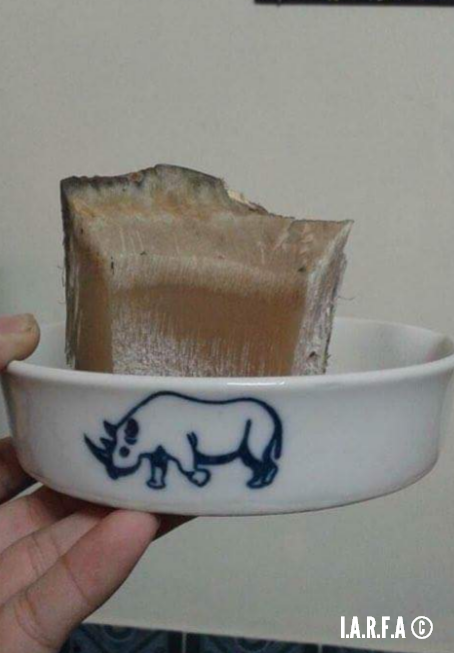
Image: Mr Tuan advertises the authenticity of recently smuggled rhino horn 11th August.
I.A.R.F.A have located over 21 African Rhinoceros horns traded illegally online and via ground markets since 2015 when we began our new anti wildlife trade operations and, 9 Indian One Horned Rhinoceros horns (all authentic). Mr Tuan, a Vietnamese national had no qualms whatsoever proving the legitimacy of his recently smuggled horn from South Africa. Anti Wildlife Trade Officers were invited to Mr Tuan’s Hanoi antiques shop of which in the back room were four recently poached Rhinoceros horns. I.A.R.F.A Anti Wildlife Trade Officers posing as interested buyers were offered the above in liquid form as a ‘so called aphrodisiac’.
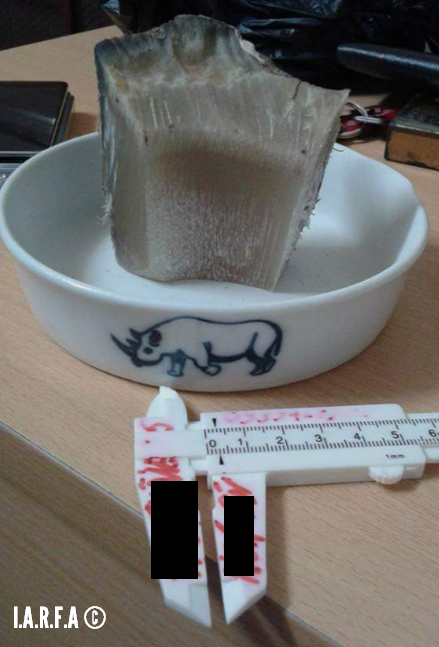
Image: Mr Tuan prepares to sell this horn to I.A.R.F.A investigators.
The above horn was measured up, weighed and offered to I.A.R.F.A investigative officers for a total of $4,000(USD). While the officers declined a small sample was purchased so that we could test the authenticity of this horn. Vietnamese investigative officers working with (I.A.R.F.A) the very next day took the sample to Viet Nam National University of which tests later revealed the horn originated from an African Rhinoceros based on the horns DNA.

Image: One of Viet Nam’s many Rhino horn kingpins. Mr Tuan.
While we don’t make a habit of exposing ‘wealthy wildlife trade kingpins’. As we’re nearing the (CoP17 summit) we believe its time to begin naming and shaming some of the dons behind this ruthless trade in order to communicate our message far and wide to all CITES members that enough is enough, sanctions must be placed against all violating countries. Mr Tuan doesn’t just deal in large quantities of authentic Rhinoceros horn neither. Ivory, pangolin parts and the critically endangered Indochinese Box Turtle also fill Mr Tuan’s home and antiques shop. So Mr Tuan if you’re reading please do say cheese.
Meanwhile Mr Tuan is just a small piece of the ever-increasing illegal wildlife trade iceberg. In one group that we’ve been monitoring for over two years that’s yielded 9 arrests thus far this year (which we cannot name for legal reasons). Some 33,000 individuals all over the globe are trading ivory, tiger parts, bear claws, pangolin scales and critically endangered moon bear skins (among many other items). The vast majority of these online traders that lead investigative officers to some ground locations are either Vietnamese, Chinese, Malaysian, Indonesian, Indian, Belgium, Australian, American and Canadian traders. One trader was even located in London W12, and two others dealing from Paris, France.
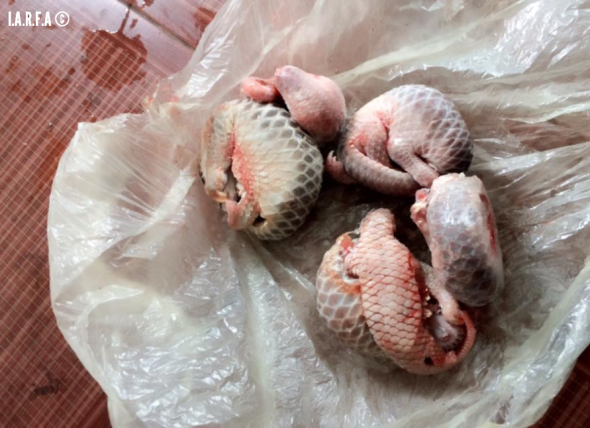
Image: Thailand smuggled endangered pangolins.
Rhinoceros horn is the least likely wildlife trade product that we come-by, simply because of its price, rarity, and the fact so many people around the globe are now putting their foot down relating to this animal part. Unfortunately its not just Rhinoceros horn that we witness being sold illegally online and on the ground. Mr Tu Su whom lives in Ha Tan, Viet Nam was clocked on the 19th August 2016 trading these smuggled pangolin parts online illegally.
Every year there are numerous arrests throughout Asia and convictions relation to pangolin poaching and trafficking, however no sooner is one dealt with - another smuggler and trader rears their ugly head, and can you blame them? All four Asiatic pangolins are now considered extremely rare to the point they’re nearing extinction. Furthermore as the species becomes more rarer - prices increase. These 6 pangolins were trading between $600(USD) and $1000(USD) each. Mr Tu Su has has quite a reputation relating to pangolin smuggling - so for the record below is Mr Tu Su’s face.

Image: Mr Tu Su - Pangolin smuggler and trader.

Image: Mr Tu Su - Pangolin soup.
All 8 species of Asian and African pangolins are ‘listed under Appendix II of CITES’, which means trade is regulated and monitored under CITES, (permits are required from exporting countries for any trade activity). To issue a permit, the exporting country must determine that this activity will have no detriment to the wild population.
As an additional protective measure, the CITES authority passed a (zero export quota for the four Asian species, which bans all commercial trade in these species). However, other purposes (scientific, research, etc.) can still be authorized by permit. For the four African species, there is no zero export quota, which means commercial trade is not prohibited, but permits are still required. Pangolins are also protected in their range states by domestic wildlife laws.
So Mr Tu Su if you’re reading then please note you’ve violated both domestic and international law, we’re holding your details too!
International Animal Rescue Foundation Africa have increased investigations relating to the illicit wildlife trade. Our two main areas of focus is that of the Rhinoceros horn trade and the ivory trade. Since 2015 our investigations surrounding the illegal ivory trade (have located a staggering $6 million(USD) of ivory smuggled from Africa into Thailand, China, Malaysia, Singapore and, Viet Nam.
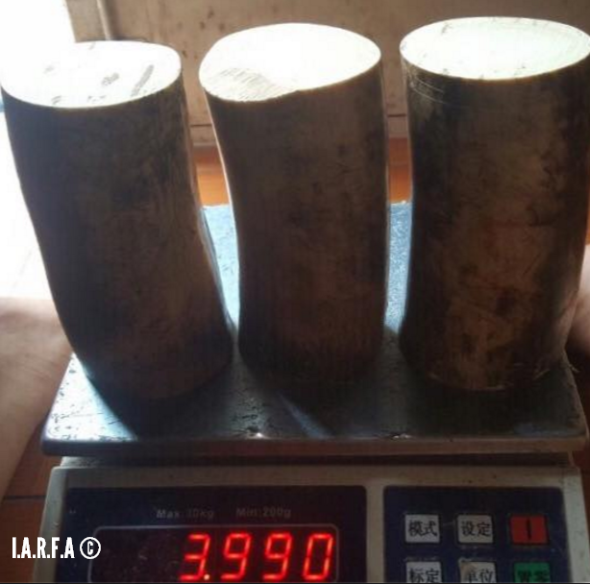
Image: Ivory trafficked from Tanzania onto Viet Nam.
Ivory trader and trafficker Mr Ban Me from Buôn Ma Thuột, Đắc Lắk, Vietnam was observed on the 16th August 2016 trading the ivory above online in one of three secret Vietnamese and Chinese ivory trading online forums. The ivory above is estimated to be around $6,500-$8,000(USD) for the lot.
Mr Ban Me makes no effort to conceal his lucrative online trade neither. When investigating this trader and trafficker we went back through many months of posts within the secret forum, then managed to locate Mr Ban Me who is aged around 35-30 years old. On locating the trafficker/trader it appears from the online evidence that ivory is coming in quick, measured up and weighed, of which either himself or friends then soon after set about to carve the ivory into jewelry.

Image: Ivory measured up and weighed for sale and carving.
Since January 2015 (International Animal Rescue Foundations) Environmental Crimes Officers have underneathed new trading trends relating to the ‘online wildlife trade’. As explained in previous articles most traders nowadays will take delivery of illegal wildlife contraband. From there the wildlife parts are then photographed (as seen in the image below). Traders will either then set up a ‘pseudo Facebook profile’ or already have one in place. The Facebook profile will act as a mobile online shop.
Most traders and traffickers we’re investigating today use this method of online illegal trading. They know by using a throw away or cheap (non-traceable cell phone) that any chance of them being located is slim. Traders are rarely seen selling in bulk on the streets of Viet Nam or over the borders in other Asian countries. Buyers and traders feel safer trading, swapping or trafficking items uploaded to the internet.
Mr Ban Me takes delivery of a large quantity of ivory every month from Africa, most of which has been illegally trafficked into China. Once carved the items are then photographed again to sell online within secret trading rooms to hundreds if not thousands of people. The ivory seen above and below was ‘advertised’ to an audience of over 33,000 individuals.
So as you can see its incredibly difficult for us or any investigate organisation to track in quick time where these products are originating from and ending up. Traders use these rooms online because they know selling to a wider-ranged audience products can shift quickly. Unfortunately for Mr Ban Me we have his contact details, his address, his cell phone numbers, and even know who is selling too and buying from.

Image: Carved ivory on sale from the tusks observed and intercepted online.
Another shocking ‘concern’ is that Mr Ban Me ‘could be purchasing ivory from Thailand elephant traders’. I.A.R.F.A have known for many years now that ivory tusks are being shaved down from Asiatic elephants. A trace of Mr Ban Me’s cell phone images revealed further evidence that showed himself photographing Asian elephants onto his ‘Facebook ivory profile’. Should this be true - it will prove to be further damning evidence that elephants are being exploited within Asia for the ivory trade on a much larger scale than previously documented.
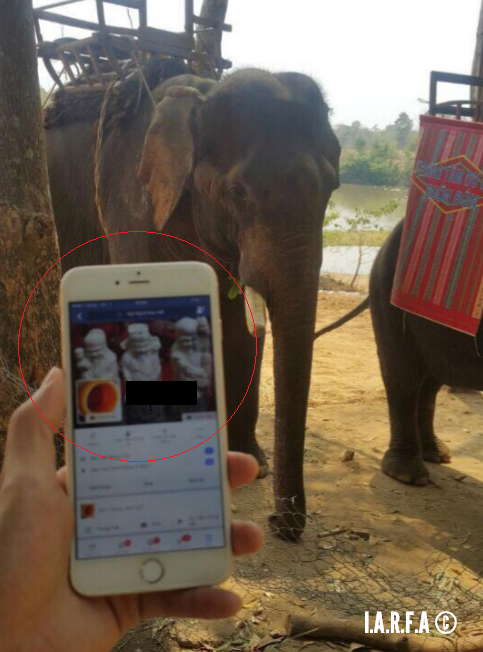
Image: Ban Me photographs Asian elephants onto ivory Facebook profile.
The only image we have of Mr Ban Me is that of his wood workshop in Viet Nam (pictured below). The entire Facebook profile (like many thousands more we have and continue to observe) depicts that of ivory and few rose wood products. The question is though - who’s supplying this young Asian man with ivory? I.A.R.F.A have demanded that Facebook and the F.B.I take action against this illicit trade, and even supplied the Social Media platform with an 11,000+ petition signature however as yet nothing is being done to combat this trade?

Image: Mr Ban Me carving wood in Viet Nam. where ivory is also traded.
Back in December 2015 International Animal Rescue Foundations (Environmental Crime Officers) passed hundreds of pages of evidence onto international law enforcement agencies and Interpol relating to illegal wildlife traders. There have been numerous arrests due to our investigation and, from that investigation other individuals have been looked into resulting in new investigations and arrests too on a global scale. However no sooner is one trader stopped - another one pops their ugly head up from the sand and begins trading.
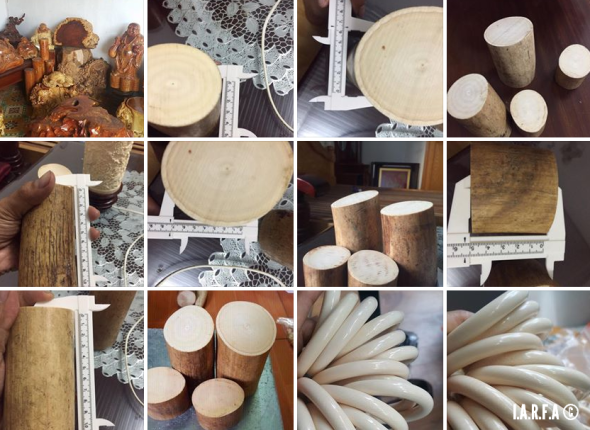
Image: Mr Ban Me’s ivory Facebook shop profile - ivory tusks, and carved ivory jewelry.
A further trader that ‘openly admitted to I.A.R.F.A Environmental Crimes Officers tried to sell these tusks (pictured below) to an I.A.R.F.A investigator. Going under the name of Mr Thường, from Hanoi Viet Nam, he like Mr Ban Me made no effort whatsoever to conceal his hoard of illicit ivory - most of which was from African elephants. Furthermore he too like Ban Me had created a ‘pseudo Facebook profile to trade illegally elephant ivory’.
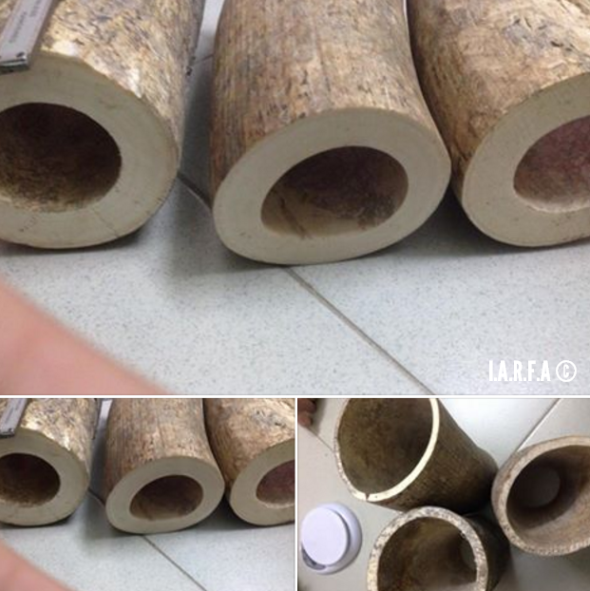
Image: One of many thousands of online Facebook ivory trading profiles.
Viet Nam banned the ‘domestic ivory trade back in 1990’. Furthermore there has been an ‘international ivory trade ban in place since 1989. Unfortunately while these bans have been in place - there are loopholes within some ‘countries domestic trades’ which permits them to trade ‘legally elephant ivory despite international and domestic bans’.
Furthermore ivory can to some extent be sold legally within Viet Nam should the products be antique or purchased before the ivory trade bans. However neither of our investigative officers have located any evidence to prove any of the ivory we’ve located was purchased/obtained legally before any bans were implemented. Damning evidence sent to law enforcement agencies around the globe also proves that ivory is being smuggled from Africa onto Japan and China then back into Viet Nam - Three countries known for their continued ivory trade violations.
While the ivory trade continues to rage out of control there are unfortunately many other illicit and illegal wildlife trades that are increasing within Viet Nam. I.A.R.F.A have noticed a very ‘alarming spike’ of bear parts, mostly moon bears for sale online and on the ground. Environmental Wildlife Crime investigative officers located this species [pictured below] - Ursus thibetanus on the 8th September 2016. The species is identified as the Ursus thibetanus and is listed as [vulnerable] on the (IUCN RED LIST) of threatened and near endangered species.
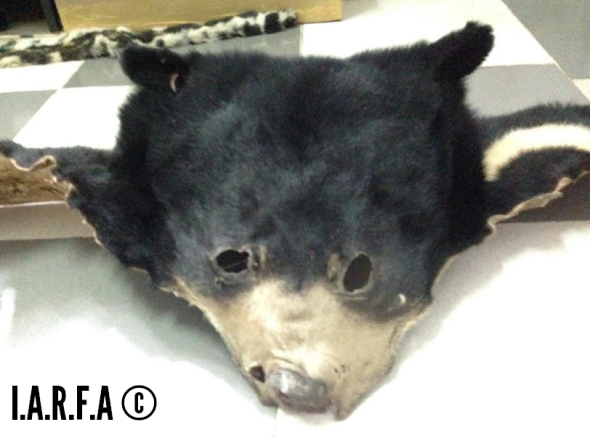
Image: Ursus thibetanus (Moon Bear parts) Viet Nam (2026).
Moon bear pelts, teeth, claws and bear bile are not exactly an uncommon species of animal to be located wihtin Viet Nam’s numerous medicinal markets, although its not common to view the species as it is above on sale within open markets. Bear bile has not decreased in sale on the TCM markets whatsoever in my humble opinion, in fact we (the organisation) hold very recent and damning evidence to prove that bear bile farming practices are sill very much operational. So damning that it does in fact bring many Non Profit Organisations into question with regards to their allegations of practically stopping this trade, when clearly its not being stopped!
Due to many counterfeit animal products on the markets, before any investigation is undertaken - Environmental Scientists will conduct routine examinations of purchased bear bile products to check their authenticity. These examinations are undertaken to store and maintain evidence files, to secure closures of illegal markets or, for further secondary investigations. I.A.R.F.A Wildlife Trade investigative officers located the following bear bile products on the market in Viet Nam.
A kilogram of farmed bear bile might cost $240, while the same amount from a wild bear could cost $15,730. Investigative officers were told the bile seen hereto in the image below was from wild bears, however we highly doubt it due to the lack of Asiatic black bears in the wild. Each bottle below was offered to investigative officers for just over $200(USD). I.A.R.F.A Wildlife Trade investigate officers did purchase three at a price of $600(USD) which is considered cheap. The ‘liquid was tested at the Nong Lam University of which proved to be 100% bear bile.
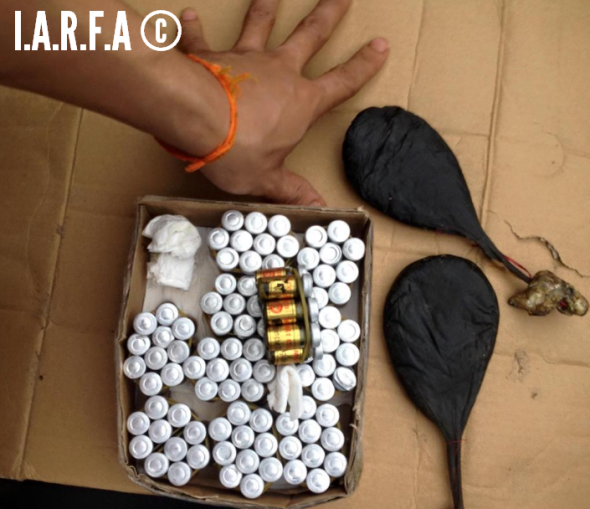
Image: Asiatic Moon bear bile in mass production with gall bladders.
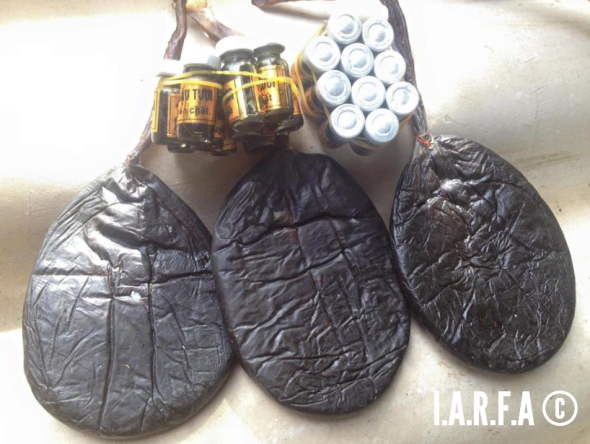
Image: Plastic wrapped gall bladders and bile.
Bear bile does not whatsoever hold any medicinal properties whatsoever, if anything consuming bear bile can actually increase health complaints. The barbaric practice is ‘illegal in China and Viet Nam’, Viet Nam banned bile production back in 1992, sadly the trade still goes on to some extent. Fortunately Viet Nam have stated they’ll be eliminating this horror come 2020, however we’re not holding our breaths just yet.
Mr Nheo who is aged around 21 years of age from the Huong District, living in Hanoi Viet Nam (pictured below) if you’re reading my friend you may want to stop trading pangolins, tiger parts, bear bile, tiger teeth, bear teeth and claws and ivory today. Bear bile hosts no medicinal properties whatsoever so why you’re trading this vile product - which leads to the destruction of bears for we don’t know..

Image: Mr Nheo - Illegal wildlife trader from Hunong District, Viet Nam.
At the last Conference of Parties Summit (CoP15 - Thailand), Viet Nam made a promise to crack down on the countries illegal wildlife trade back in 2013. Although there was no actual deal made, Cites signatories did categorically state that should Viet Nam want any say in the ‘legalized international trade of rhino horn’ the country must clamp down on illegal wildlife trades and markets. I was at the last CoP summit of which Viet Nam agreed it was time to reduce their illegal trade markets - or face the consequences.
The whole purpose of this article and many others is to ‘highlight Viet Nam’s lies; the country hasn’t in my opinion made any progress to reduce their illegal wildlife markets, especially that of (critically endangered species). Yet Viet Nam has been identified as one of the leading countries to be approaching Cites for the ban to be lifted relating to the (international rhino horn trade). I ask myself daily - how is it possible for a country to control any legal trade if they cannot control the illegal trade of wildlife contraband?.
I.A.R.F.A. Environmental Crimes officers working online and on the ground furthermore have noticed a colossal spike in the number of tiger parts and dead tiger carcasses sold within Viet Nam’s illegal wildlife trade markets. The image below depicts a trader that is privately trading tiger teeth. While the quantity of tiger teeth wihtin the image (below) may seem small. I.A.R.F.A Environmental Cyber Crimes officers have been carefully monitoring this trader for well over a year. The vast amount of tiger parts he’s trading is out of this world.
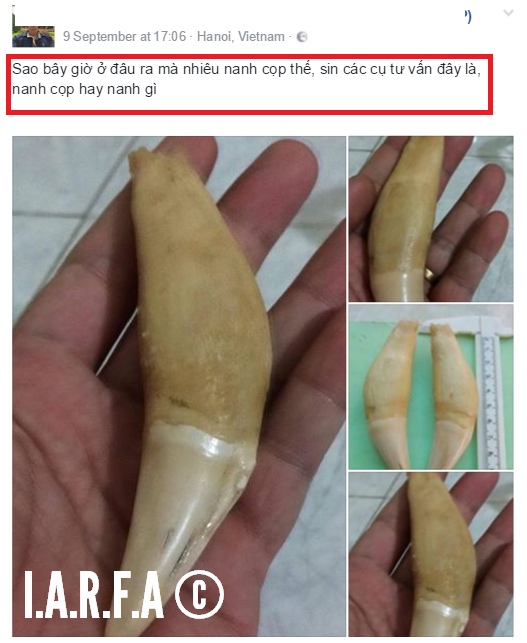
Image: Tiger teeth for sale- Online Secret Wildlife Trading Forum.
I.A.R.F.A have reported various tiger traders in Viet Nam to INTERPOL and local enforcement agencies. However as explained these bloody sickening traders, traffickers and animal killers continue to pop up time again. Most if not all the tigers that we are locating for trade (illegally) were ether captive tigers, smuggled tigers/parts from China and/or Thailand. While other specimens have actually originated from (pathology/veterinary universities inside of Viet Nam).
Three months ago I.A.R.F.A working with overseas enforcement experts concluded - the rare Asiatic leopard we located within a wildlife traders apartment had originated from a veterinary university in Viet Nam. Meanwhile the tiger skins/parts below have originated from Thailand. The question is though from where, who is supplying this amount of tigers and parts to traders within Viet Nam?
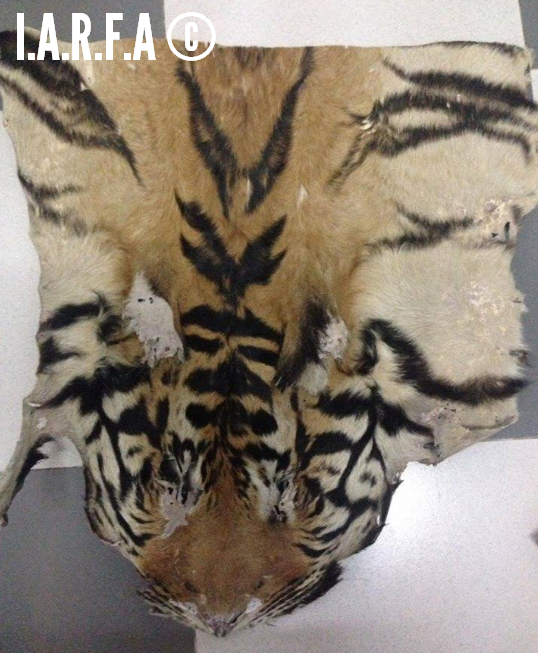
Image: One of many tiger skins offered to I.A.R.F.A investigators September 8th.
International Animal Rescue Foundation Environmental Cyber Crimes Officers was offered this tiger pelt for $1,060(USD). The trader that operates under the name of ‘Mr Coivodich’ also deals in ivory, threatened Rhinoceros hornbills, and bear bile. Furthermore we have been monitoring a very ‘concerning trend relating to tiger skin wallets. Captive bred tigers are slaughtered of which their skins are turned into wallets - a craze that is now becoming incredibly popular throughout Viet Nam. Tigers in Viet Nam are supposed to be bred for conservation purposes only. Clearly though from the images below this is not the case.
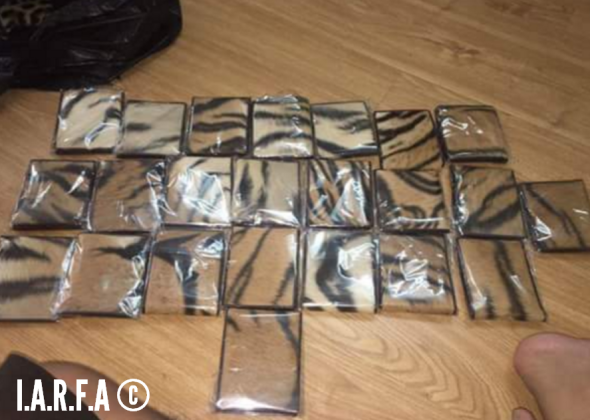
Image: Real tiger skin wallets packaged and ready for sale in Hanoi.
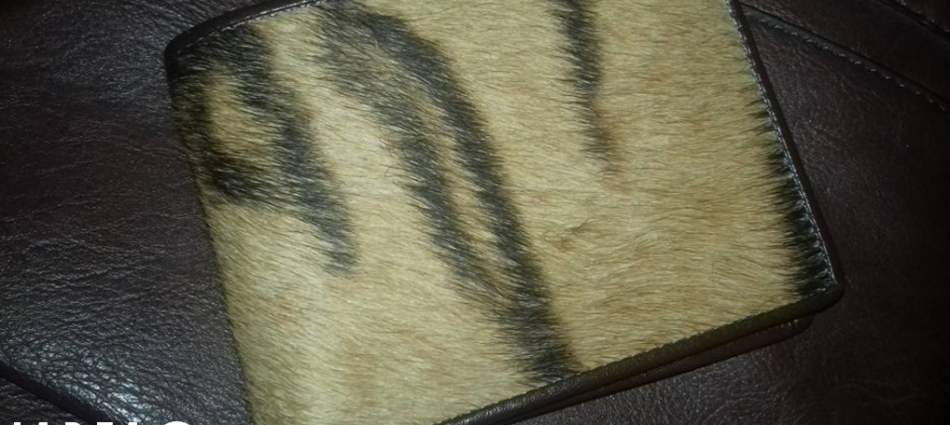
Image: Unpacked real tiger skin wallet, priced at $70.00(USD) each.
As explained tigers are supposed to be used for conservation purposes only. However we have located worrying evidence that makes Tiger Temple look more like a walk in the park. A famous Thailand Actor below is seen cuddling a drugged tiger at the Sriracha Tiger Zoo which we believed was a zoo inside of Viet Nam. (See image below). Unfortunately the tiger and this image eventually led back to Thailand, of which this zoo has been named as a horror ground. Would it be wise to assume that tigers are originating from this zoo and ending up within Viet Nam’s wildlife trade? We don’t know. What we do know for sure though is this zoo is now under close scrutiny.

Image: Chen Yunan coaxes drugged tiger in Thailand.

Image: Ranya Rao coaxing drugged tiger in Thailand.
International Animal Rescue Foundation’s Environmental Crimes teams have been working on our new anti wildlife trade project since 2015 being now the ninth major project that we have conducted in the past three years. Most of the evidence we are locating in relation to wildlife trade violations isn’t always within China - a lot of these violations are in fact within Viet Nam.
We are now under four days away from the next Conference of Parties (CoP17) to be held within South Africa, Johannesburg. CoP 17 has been set to be the largest summit held, and as such we may see countries such as Viet Nam asking Cites signatories to agree to a lift of the international trade ban in Rhinoceros horn. Every article that we’ve published in relation to Viet Nam shows the country cannot be trusted with relation to the international rhino horn trade. Every article we’ve published also shows numerous violations of local and international wildlife trade laws.
So the question remains. Is it now time to implement at CoP17 full part of full sanctions against Viet Nam to protect our local and international wildlife? I believe its now time. The evidence in front of you clearly shows Viet Nam’s refusal to act on their illegal wildlife trade markets. So how much more do we have to put up with before everything is eventually gone? Should Cites signatories lift the rhino horn trade ban we’ll keep to our promise. Being all those we know dealing in illegal wildlife products at high end market level will be named, shamed addresses published and that evidence released to the public. Video recordings, audio, images - everything.
The balls now in Cites court - Don’t underestimate us, we may be quiet - but we’ll stay quiet for only a short time before we begin naming and shaming.
Dr Jose C. Depre. PhD. MEnvSc. BSc(Hons) Botany, PhD(NeuroSci) D.V.M.
Environmental, Botanical & Human Scientist.
WHY ARE WE STILL HUNTING RHINOS FOR | WHEN NO AMOUNT OF FUNDING HAS REDUCED POACHING?
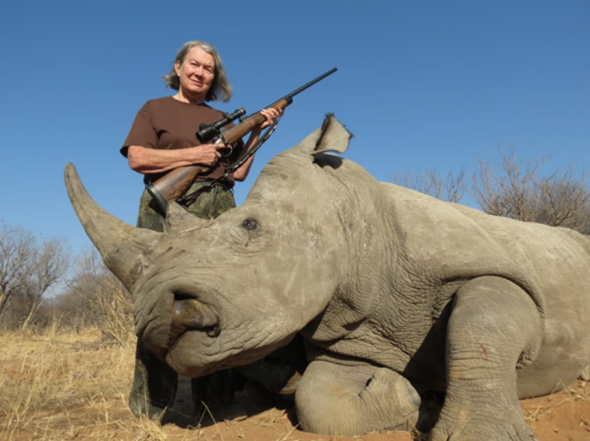
WHY ARE WE STILL HUNTING RHINO?
Why are foreign and native Africans still trophy hunting Rhinoceros for, when no amount of funding generated from these hunts has actively decreased poaching? Image credit: (Mrs Janice Hull, Limcroma South Africa).
Over five years ago I and a group of dangerous game hunters (DGH’s) were involved within a heated debate relating to the money allegedly generated from rhino hunting. The question I asked (and continue to ask) was: “Why are we still hunting rhino for when the money generated from these hunts doesn’t appear to be having any affect whatsoever on decreasing rhino poaching or increasing conservation efforts and security for African rhinos”? (Image above: Hunter - American Janice Hull).
The answer[s] I received were mixed opinions, abuse, and lies. I aimed this question at a number of professional hunters - (PH’s) working in South Africa, and Namibia most of which were American. While the vast majority of dangerous game hunters stated money raised from hunts was directed back into rhino conservation, I’m still after five years questioning where this money is actually going because rhino poaching is not decreasing whatsoever?
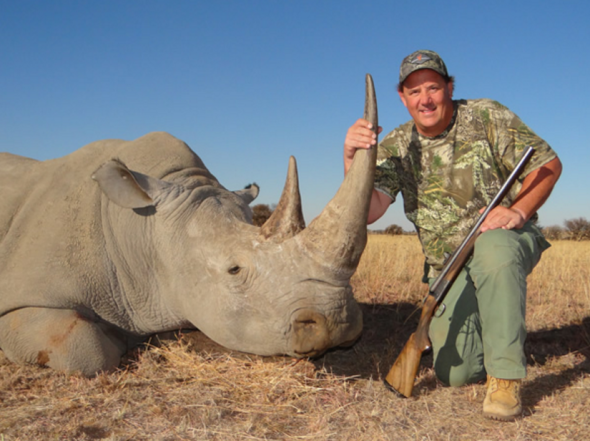
Image Credit: Trophy hunter Mr Loddie Naymola
Since 2008 poachers have slaughtered a staggering 5,940 Rhinoceros - most of which have been poached within South Africa’s flagship park identified as the Kruger National Park. From the year of 2007 rhino poaching figures began increasing rapidly. A total of 13 rhino were bludgeoned to death in 2007. Meanwhile in 2009 South Africa lost a further 122 rhinos (due to poaching).
However come 2011 we really began to see poaching figures rise, come the end of December 2011 a whopping 448 rhinos had been slaughtered by poachers to fuel the Asian demand for pseudo rhino horn medicine. Come 2013 figures shot through the roof resulting in some 1,003 rhinos poached stated the Department of Environmental Affairs come 2013 December end. Then the largest stats were reported back in 2014 of which South Africa lost some 1,215 Rhinoceros to poachers. Yet ‘hunting revenue is preserving our ionic species’?.
Unfortunately at some point from 2014-2016 the Department of Environmental Affairs Minster Honorable Edna Molewa placed a complete ban on the public reporting of any rhino poaching figures, there was no reason as to why this ban was implemented, of which to date still remains in place. Coincidentally (2015’s poaching statistics) had decreased somewhat - of which come December 2015 some 1,175 rhinos had ‘allegedly been poached’. Isn’t that coincidental, a blanket ban on poaching figures is ordered, then come the next year a decrease is seen!.
SOURCE: POACHING STATISTICS.
The SOUTH AFRICAN DEFENCE WEB stated back in January 2016 that a ‘lack of rhino poaching information was negatively affecting anti poaching’. However despite the governmental blackout on rhino poaching incidents numerous organisations such as ‘Stop Rhino Poaching and ‘Outraged South African Citizens against Poaching’ had reported via media, press and anti poaching reports a small rhino poaching decline.
However both of these organisations didn’t obtain their reports from the government, or did they?. So last years poaching stats could indeed be higher than what has been stated in the public domain. Furthermore both Facebook/Online groups/NGO’s share there statistics openly. So in all honesty there is no evidence whatsoever to prove a poaching decline from 2015 has occurred. Moreover and as explained - I myself find it awfully suspicious that since the 2015 poaching report blackout by the South African government - poaching stats just coincidentally decrease like that?.
Elise Daffue whom ‘allegedly runs some form of rhino intelligence group’ (on Facebook - identified as Stop Rhino Poaching), and not in the actual field, stated: “The drop in kills is testimony to the huge effort being made on the enforcement side. Environment Asset Protection strategies have been formulated and implemented over the past three years, guiding the strategic and operational plans nationally – from the ranger in the bush who detects the spoor to the prosecutor who fights that bail is denied. Keeping the numbers down depends entirely on good field work and reserve security, good investigations and good convictions”
While Elise Daffue has stated there was a drop in rhino poaching due to a “huge effort being made on the enforcement side” there remains no evidence whatsoever proving there has been a decline in rhino poaching from 2014-2015. Moreover if there is evidence where has this data come from?. Furthermore whenever we see hunters and ‘animal lovers mingling together’, regardless of what you state your organisation is and does - alarm bells begin ringing, especially coming close to the next CoP summit.
The Founder of Stop Rhino Poaching is friends with a hunter identified as Gustav Collins who runs the Mattaniah Game Reserve Furthermore Elise Daffue is also associated with the individual known as Simon James Naylor who is the Conservation Manager for Phinda Private Game Reserve of which has connections to various hunting organisations and the (WWF) that supports sustainable hunting of Rhinoceros within South Africa and Namibia. Finally (among many others) we have Mr Mark Lautenbach who works as a Specialist Freelance Guide at Ukuthula Lodge. Elise Daffue founder of Stop Rhino Poaching is also friends with a Department of Environmental Affairs worker, and numerous other governmental bodies, police and hunters.
While the above details may not seem overly important, when we’re trying to locate data on hunting statistics, money generated from these activities and more, suspicions are raised when we locate so called professional organisations that are connected to numerous hunting organisations; and institutions such as ‘petting farms’ I.e Ukutala Lodge that has connections with the canned hunting industry and, has featured in a (Blood Lion documentary).
So as one can see it all becomes rather confusing when all we want is upfront and honest answers, however when we ask questions and later find out there are numerous connections to the hunting and possibly ‘pseudo hunting trade’ will we even obtain a serious, straightforward and honest answer? When we’re lied to by hunters, how can we possibly trust Non-Governmental Organisations that are aligned to the very people whom are lying, and are hunting our rhinos while pretending to be so called conservationists? Moreover we (the organisation) do not believe there has been any decline whatsoever relating to rhino poaching. We do though believe that this so called ‘decline may be playing a role in this months CoP17 Summit’ relating to rhino horn legislation.

Image Credit: European trophy hunter, Mr Dennis Schemmel
Back in July 2016 it was reported that Rhinoceros poaching was finally without a doubt at ‘tipping point’. South Africa has seen the largest poaching rates recorded at some 72% from 2011-2015. Namibia recorded a loss of 10.8% from 2012-2015. Zimbabwe recorded a loss of 3.1% from 2012-2015. Kenya has recorded a loss of 4.4% from 2012-2015. Finally ‘other African range states mainly in Central Africa’ recorded a loss of 2.5% from 2012-2015.
While its been reported that some 25,000 Rhinoceros remain on the African continent - a depressing near six thousand have been poached all over the continent from 2012-2015. Yet hunting revenue from one of Africa’s most expensive game animals is allegedly reducing poaching? How is this possible, when we’ve lost so many rhinos, and reports from the Global Initiative have confirmed ‘rhinos are at tipping point’.? Furthermore how can the hunting community continue to state that revenue from rhino hunting is helping to secure the rhinos future when 1. It clearly isn’t due to poaching statistics increasing, and 2. The majority of hunters today are now supporting an international rhino horn trade ban lift?
The Global Initiative stated: “Dozens more rhino have been shot in so-called “pseudo-hunts”. Across Europe, castles and museums have been raided by criminal gangs in search of rhino horn trophies. And in the United States, businessmen, antique dealers – even a former rodeo star and a university professor – have been implicated in the illicit trade”. Driven by seemingly insatiable demand in Southeast Asia and China, rhino horn has become a black market commodity rivalling gold and platinum in value.
SOURCE: GLOBAL INITIATIVE.
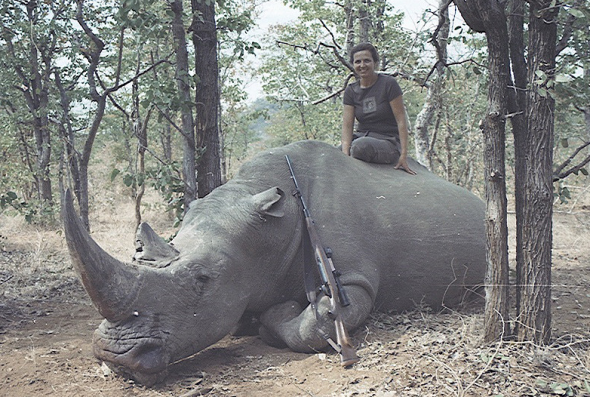
Image: Female rhino hunter, origin of hunter unknown and name. South Africa?
To date there has been very little forthcoming information in relation to revenue generated from African rhino hunts, and where exactly this hunting money is going. Furthermore with rhino poaching still increasing, and tipping points now recorded by ‘various trusted organisations’ the question must now be raised why are we still hunting Rhinoceros?
From the 1940’s tiger hunting was common among many international and local tourists in India. However so too was tiger poaching. It was alleged that revenue from tiger hunting was actually helping to preserve the tiger species and other mammals too. Unfortunately this turned out to be complete codswallop. Then in 1973, the Indian government finally under the orders of Prime Minister Indira Gandhi banned tiger hunting due to so many tigers being poached - and legally hunted at the same time. Had Prime Minister Indira Gandhi not instigated ‘Project Tiger’, the tiger would have gone extinct way back in the 1970’s.
SOURCE: PROJECT TIGER.
In the last 50 years the tiger population in Asia has plummeted from 100,000 to about 5,000. The number of tigers is dangerously low, and the conservation of the world’s remaining tigers is of global concern. Now, in this volume, 40 world authorities on tigers from Asia, Europe, and North America have summarized and identified the management, conservation, and research needs for this endangered species. Before Project Tiger was implemented tiger populations were being hammered. The same identical hunting and poaching behavior before Project Tiger can now be witnessed in Africa - primarily in South Africa where rhinos are also being hammered both by hunters, poachers and pseudo hunters. Does that ring alarm bells among the many FAKE NGO’S out there?
International Animal Rescue Foundation Africa undertook various searches relating to rhino hunting and revenue generated from these hunts within South Africa. What we found was from 2005-2015 a total of 330 ‘White Rhinoceros’ had been legally hunted from 2005-2015. The minimum hunting price was exactly $50,000(USD). While the maximum hunting price was exactly $150,000(USD). It was found that from 2005-2015 and based on the assumption these were (white rhino hunts only) and, taking into consideration the minimum price first. Revenue generated from rhino hunting at the price of $50,000(USD) resulted in an estimated total $181,500,000 million - that’s $181 million(USD) raised from hunting. Meanwhile, and taking into consideration the highest price (being $150,000(USD) a total of $554,500,000 million was generated.
While we cannot place these two equations together and provide a factual sum because we don’t know how many rhinos were legally hunted at each individual price, the sheer fact that millions of dollars has been generated from 2005-2015 should be enough to explain that something isn’t quite right here. Furthermore these figures are based on the assumption these were white rhino hunts,
MINIMUM HUNTING PRICE: 2005-2015 = $181,500,000 million(USD)
MAXIMUM HUNTING PRICE: 2005-2015 = $554,500,000 million(USD)
SOURCE: HUNTING REVENUE.
SOURCE: REPORT TROPHY HUNTING.
To date (and as you can see within the sourced links above) there still hasn’t been a single reliable report that confirms just how much money is being made from trophy hunting in South Africa. The only so called reliable report (which is about as reliable as a chocolate teapot) and, being the only report to surface thus far stated that $200 million(USD) was generated from the years of 2010-2011 (in regards to all South African trophy hunts)? Who number crunched these figures, who even dared to come up with such an absurd low revenue income? I would also like to remind hunting organisations, just because you don’t have to tell us what you’re making, we can contact other organisations/institutions, locate prices, we can phone and email. Eventually we’ll find the truth!
Now either our expert eyes and our mathematical friends are missing something here, or journalists media and the pro trade lobby are forgetting that despite hunting revenue being made pubic. Environmental Scientists can research CITES trophy hunting statistics, then locate the common maximum and minimum price, and the number of rhino trophy heads exported/imported. So as one can read above just from the years of (2005-2015 - millions was made just from Rhinoceros hunting). Moreover who ever came up with the 2010-2011 sum of $200 million USD clearly is missing a lot of money off here, and needs to undertake a mathematical course too?
Rhinoceros hunting is by far the biggest money maker within the hunting business (most of this money is made in South Africa which hosts the largest rhino populations on the planet). Furthermore it just seems too coincidental that from 2010-2011 literally every hunting organisation that’s promoting/advertising rhino hunts has mysteriously removed their prices.
Trophy hunting of rhino is strictly regulated. Every year a total of five (black rhino) can legally be hunted within each of Namibia and South Africa, which totals to a maximum of (ten) per year - five per country. Furthermore in South Africa and Namibia one white rhino can be hunted by one hunter per year - that’s one rhino per hunter every year. Unfortunately there remains no further hunting revenue and data from the years of 2014. Its been estimated by the National Geographic based on the United States Fish and Wildlife report that the United States imported a total of 328 white rhino trophies from South Africa from the years of 2005-2014. Meanwhile a total of 7 white rhino were hunted and subsequently imported to the United States from Namibia from the years of 2005-2014.
SOURCE: NAT GEO HUNTING DATA.
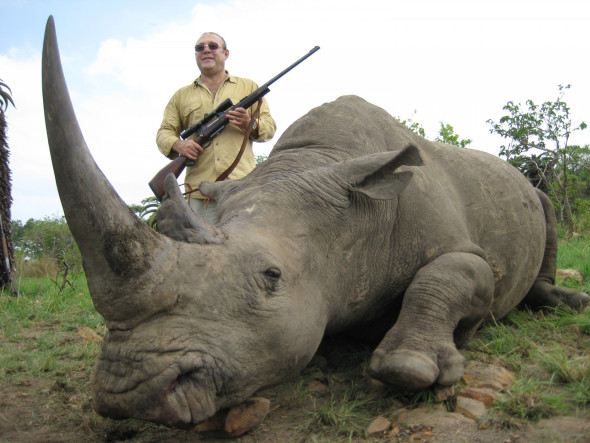
Image Credit: Rhino hunter Alexander Tseytlin
Black rhino hunts have provoked much controversy over the past five years mainly because black rhinos are actually listed as (critically endangered), hence why only five black rhinos can be hunted per year in South Africa and Namibia. Since 1996-2011 the species has been listed as near extinct on the International Union for the Conservation of Natures Red List. Fortunately due to ‘private farming conservation efforts (not wild efforts) the species has allegedly and gradually increased (primarily due to hunting?)’. Both private and wild populations are believed to be increasing within South Africa and Namibia placing the total species population count from 2010 at 4,880 black rhinos.
SOURCE: IUCN BLACK RHINO.
The only reports that we ourselves can offer in regards to black rhino trophy is that of media and press reports that have documented on large scale bidding for black rhino hunts. In January 2014, Corey Knowlton bid $350,000 for a permit to hunt and kill a black rhino in Namibia (Source: Corey Knowlton). Back in June 2016 Namibia offered up three of its black rhinos to trophy hunters. While the price has not been documented its most likely be in the region of just over $1 million(USD) for the three Black Rhinoceros (Source: Namibia black rhino hunt).
Meanwhile back in 1996 a game rancher named John Hume paid about $200,000 for three pairs of endangered black rhinos from the wildlife department of the South African province of KwaZulu-Natal. Among them was a male who would come to be called “Number 65,” and whose death would play a central role in the debate about conservation.
When the black rhino bull arrived, Hume’s farm manager — a burly Zimbabwean named Geoff York whose typical mode of dress is army boots and a pair of purple shorts — tranquilized him, clipped two notches in his left ear and two in the right, and gave him a number: 65. Mr John Hume later picked Mr Peter Thormahlen to organize the killing of ‘number 65’. The price was set at a $25,000 deposit on a $150,000 fee for a seven-day hunt.
Most of that would go to John Hume - the very man that is today advocating for an international legalized trade in rhino horn and has connections to a wide number of organisations such as, WWF, IUCN, CITES, The Department of Environmental Affairs and numerous other figures. Then on July 23rd 2005 Thormahlen and his client with John Hume tagging along proceeded on foot. Suddenly the rhino noticed them and rose from the dirt. The client pulled the trigger, and the first bullet pierced Number 65’s skull. The rhino, still standing, turned. A second bullet hit, and the rhino dropped dead. (Source: John Hume Rhino Hunt).
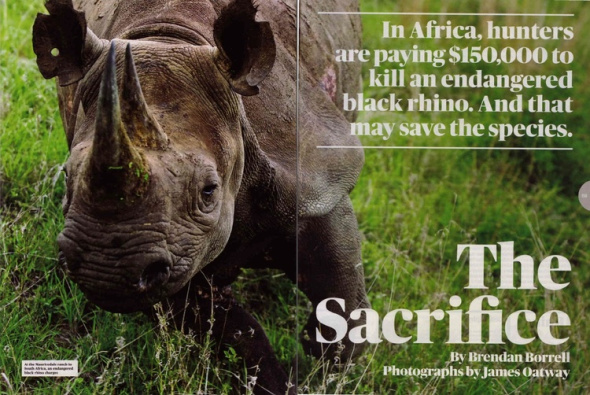
Source: The Sacrifice, please click the source tag for more info
As you can read there is a staggering amount of money parting hands to hunt both black and white rhino. Yet poaching is still skyrocketing? South Africa has lost from 2008 almost 6,000 rhinos to poachers. Back in 2014 Namibia lost a total of 24 rhinos to poaching, then come 2015 a whopping 60 rhinos were poached. (Source: Poaching stats Namibia).
So the question still remains just what exactly is all this money going towards, can each professional hunting organisation prove to me, my organisation and the public that the money generated from rhino hunting is indeed being used to fund anti poaching operations, security, conservation, education, awareness and horn poisoning? (Etc).
While I’ve been extremely silent on this issue too since 2011 I’m going to make it pubic now. I dislike the fact that a ‘prominent South African game hunter’ is involved with the Rhino Orphanage. Back in 2011 we (the organisation) were going to submit funding for scales and equipment, however when running a trace on whom ran the main website, down to a trace on that individuals Facebook page, and more we later discovered a ‘silent partner’ that is hunting many of the big five..
..So who do we trust when it comes to facts and figures? How can we trust anyone that is stating hunting is indeed increasing rhino numbers when literally every individual and organisation are in someway aligned to one another in South Africa and over the borders? Can the Rhino Orphanage and its ‘affiliate’s’ also prove that every single rhino that’s been saved has been released back into a reserve, and not hunted for sport that clearly from this entire document has proved - no amount of hunting whatsoever is increasing rhino populations!
Hunting operations are indeed expensive. While the price of a hunt may indeed seem high. One also has to take into consideration what the farmer and/or professional hunter has to pay for too. Upkeep of land, maintenance of vehicles and buildings, fuel, service charges for gas, electricity, water, and rent Etc, food and beverages for the visiting hunters, guest house uses, damages to guest houses, travel, firearms (among many other bills). Then of course comes anti poaching being the last bill. Some of this expense can be viewed below.
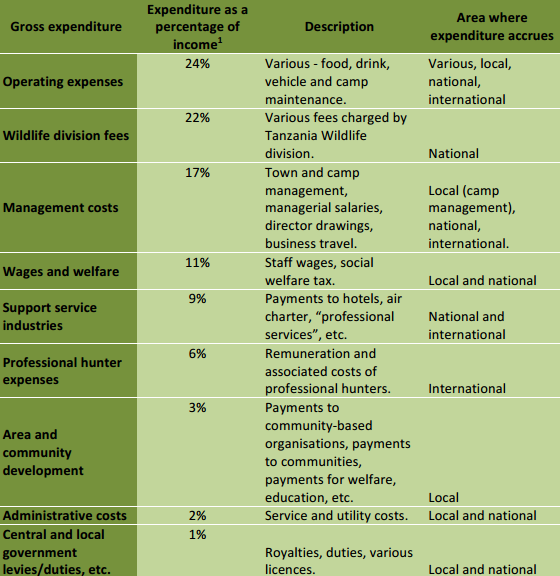
Image: Hunting Charges (Source: IFAW)
While we know that Rhinoceros trophy hunting is indeed expensive, poaching is unfortunately still increasing in various African countries, please do check the sourced links out above, and read that data carefully. The image above with source proves that no big five farmer is taking every single dollar or euro that’s advertises rhino hunting on their site or allows rhino hunting on their property.
So the question remains why are we still hunting rhino for? The question I’ve answered. Rhino hunting is nothing more than a overpaid sport that does nothing whatsoever for conservation and, is not under any circumstances whatsoever contributing to decreasing poaching. All these millions if not billions being made yet here we are still seeing rhinos poached. Finally, and the very best question of them all. If hunting revenue from rhino hunts is not decreasing poaching, how the hell is a so called sustainable rhino horn trade going to decrease poaching? Same money - same prices - going nowhere!
Thank you for reading.
Dr Jose C. Depre PhD. MEnvSc. BSc(Hons) Botany, PhD(NeuroSci) D.V.M.
Master of Environmental, Botanical & Human Science.
Environmental, Botanical and Human Scientist.
CYPRUS: WELCOME TO THE SONGBIRD KILLING FIELDS.
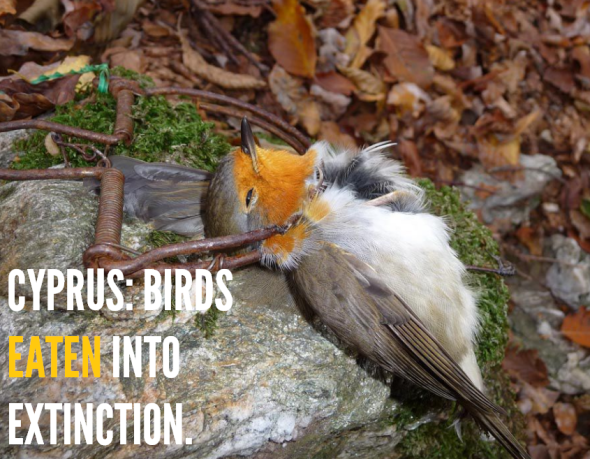
WELCOME TO THE CYPRUS KILLING FIELDS
Just over a week ago, while walking through the local woodland gardens, I noticed a little European robin that just happened to perch next to a fence no more than a few meters in front of me. I was taken aback because, this was the first robin sighting in as many years, today its actually quite rare to spot them, and while I embraced the moment, it dawned on me, why wasn’t I witnessing more of these beautiful birds within the wild?.
Robins normally head south to winter on the Continent, joining other robins passing through in the autumn on their way from Scandinavia and northern continental Europe. Interestingly, it has been shown that many migrating robins are faithful to both their summer and winter territories, which may be many hundreds of kilometers apart. Regardless of where they migrate though I myself and many other conservationist’s are seeing fewer and fewer robins and other song birds.
Every day when I awake I spend a few minutes trying to identify the number of songbirds singing within the wild within the confines of my garden. One can normally identify each individual species of bird by its unique signature melody. As a young boy it was almost difficult to identify more than a handful due to so many songbird species inhabiting the local areas. Today I can identify no more than two or three if that, and in relation to the rare sightings of robins and songbirds - this tells me only one thing - we’re losing our songbirds at an alarming rate!.
Its estimated every year that a staggering TWENTY SEVEN MILLION songbirds are slaughtered on the Mediterranean. Songbirds are unfortunately ending up on the plates of many Cypriots - to the tune of some 1.3 million, of which this number is increasing every year. Cyprus like every country hosts a wide range of traditional and culinary delights. However this culinary tradition must come to an abrupt end - very soon across the entire Mediterranean (not just Cyprus), failing this mass songbird extinctions will occur.

Image: Poached robin, (inset) ambelopoulia song bird delicacy.
Unfortunately one of them so called ‘traditional culinary delights’ is that of boiled songbirds. And please don’t for one minute think I’m singling out Cyprus here. My own country hosts a number of nauseating traditional foods that sees ducks, geese even swans butchered to provide Foie Gras and, songbirds too. Germany sells a number of robin dishes, while Malta is an even bigger offender killing hundreds of thousands of birds every year just to provide a so called “traditional food” for the locals and foreigners. Songbirds are vanishing from the Mediterranean, and the rate at which they’re being eaten is very likely to push many species into extinction in the next decade.
Cyprus has a plethora of customs due to its long history and tradition and numerous distinctive dishes for visitors to taste. The best place to do this is in one of the many traditional tavernas dotted around the island’s attractive villages, where one could order a selection of Cyprus dishes such as koupepia, souvla, kolokasi, pourgouri, seftalies and makaronia tou fournou to name just a few. For the ultimate gastronomic experience in Cyprus, the best way to try all of these and more in one sitting is as ‘mezedes’, a selection of more than 20 vegetable and meat dishes – make sure you are hungry as food will be plentiful.
However while all of these dishes may sound, look and even taste nice, a large minority of individuals on the island of Cyprus (not all), indulge in the local and traditional delicacy of boiled or grilled songbirds. Back in 1974 the government of Cyprus was lobbied and pressured to ban songbird trapping, and poaching. Today its currently still illegal to trap songbirds (as seen in the image above). While these laws prohibit anyone from illegally trapping, killing and serving up ambelopoulia - the law is very rarely enforced, which does concern us dearly. Furthermore what’s the point in having laws in place (since the 1970’s) if you’re not going to follow through with them?
AMBELOPOULIA
Mention ambelopoulia to a songbird - and it sends shivers through them, (well not literally); ambelopoulia is though the main Cyprus culinary delight - of which songbirds are pickled, roasted, grilled or boiled served with a number of vegetables or sweet fruit sauces. The traditional food normally involves boiling songbirds. The two common species of birds eaten are that of blackcaps and European robins - which is probably why I’m seeing fewer songbirds every year.
As a result almost 2,418,000 birds across the whole of Cyprus were estimated to have been killed during 2010. According to a BirdLife Cyprus report released in 2014, over 1.5 million migrating songbirds are killed annually, and the number is increasing each year. In 2015 it was estimated that over 2 million birds were killed including over 800,000 on the British Territories. Now there are new reports issued this year by various bird groups that confirm we are losing a staggering 27 million songbirds every year on the Mediterranean - many of which are killed for human delicacies.
Songbirds are trapped, killed, trafficked and consumed within many European countries. Spain, Germany, Italy, France, Belgium, Greece, Romania, Serbia, Slovenia, Russia, Malta, and of course Cyprus - all of which is mostly illegal. What makes matters even worse (in relation to Cyprus) is that a large number of songbirds are actually killed on the local British military bases on the island, so why are the Brits allowing this dare I ask?. Birdlife Cyprus stated in a report this year: “Over 800,000 birds were trapped and killed illegally on a British military base in Cyprus last autumn, according to the latest research by the RSPB and BirdLife Cyprus”.
Organised crime gangs are running this illegal practice on an ‘industrial scale’, which is estimated by the Cypriot authorities to earn criminals on the island 15 million Euros every year. Survey data from BirdLife Cyprus and other organisations have recorded over 150 species of bird which have become trapped in mist nets or on lime-sticks (pictured below). More than half of these species are of conservation concern. On a positive note, the results from 2015 show that there’s been a stop to the ‘annual increases’ of the last five years in numbers of birds killed on British Territory, thanks to various measures taken to tackle the problem by the Base authorities. The numbers however remain around record-breaking levels, with levels of illegal killing still far worse on British Territory than in the Republic of Cyprus.
The trappers defend their activity by citing the practice as traditional Cypriot food gathering and claiming that this has been an important source of protein for the natives for many thousands of years, even though the practice has been illegal since 1974. BirdLife Cyprus has identified restaurants as the main culprits as they provide the financial incentives. The enthusiasm Cypriots and many other visitors to the island have for this delicacy despite its illegality has resulted in the development of a very profitable industry.
Poaching for ambelopoulia has been on the rise in recent years, involving by 2011 a “mafia-like operation” that include poachers, dealers, exporters, and restaurant operators that participate in the illegal business estimated to be worth about 5 million euro at that time (2011). The birds reportedly sell for five euros each and it is estimated by Cypriot authorities to have earned criminals on the island 15 million euro in 2015.
LIME STICKS
Cypriot poachers illegally poach songbirds using a number of methods. One of them (seen pictured below) are lime sticks. The use of lime sticks is ‘strictly illegal’, however as explained above, despite laws in place on the island local authorities still turn a blind eye.
Lime sticks are a simple but particularly cruel and indiscriminate method of trapping birds. ‘Twigs’ are covered with a sticky ‘lime’ or ‘glue’ (in Cyprus trappers traditionally used a concentrate made from boiled Syrian plums) and are placed wherever birds can be tempted to perch. This could be in natural vegetation like bushes or trees, or sometimes lime sticks are pushed into the ends of bamboo poles. And as you guessed - once the bird lands on the lime stick they are stuck fast.
The more the bird struggles, the more it becomes entangled within the sticky like natural/unnatural substance. Songbirds die a horrific death, struggling for hours before being crushed to death by poachers, or dying of extreme exhaustion and stress. Just in one area (such as local gardens alone), its estimated that ‘hundreds of lime sticks are set up to catch as many birds as possible’. More than TWO MILLION songbirds are illegally poached using this method of trapping - which is cruel, painful, and totally barbaric.
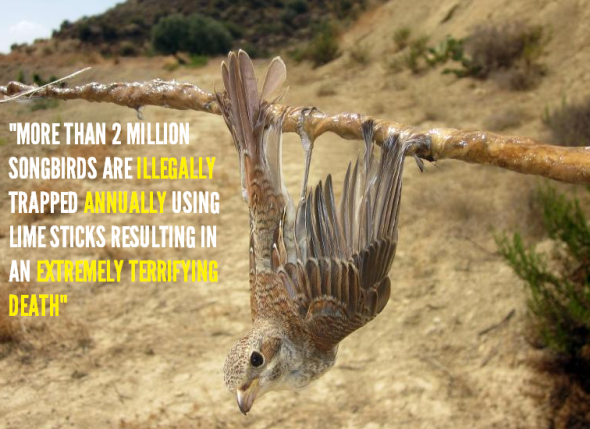
Image: Lanius collurio (Red Backed Shrike) trapped using a lime stick.
In Cyprus alone its “estimated that some one million songbirds are caught using this method of illegal trapping. Most of the sticks are set up within residents gardens - which makes policing even more difficult. One must also think - how is it even possible for every single home within Cyprus to be monitored by the local authorities?.
Lime sticks are so effective because when a bird lands its legs bend causing two flexor tendons to tighten which ‘lock’ the toes around a perch. This involuntary reflex (designed to stop perched birds falling while they sleep) means that the bird in effect presses down hard into the ‘lime’ as soon as it makes contact with it. Birds become stuck immediately. As they flutter to free themselves their wings, head, and even beak will often become stuck too.
“TRAPPERS RIP THE BIRDS FROM THE LIME STICK AND CRUSH THEM TO DEATH”
Birds caught on lime sticks are unable to get free and hang helplessly – often for hours – until the trapper comes and literally rips them off the stick and crushes them to death.
Article 9 of the European Birds Directive (2009/147/EC, formerly 79/409/EEC), states that trapping methods that are non-selective or are used for large-scale capture or killing of birds are prohibited in European Member States. This includes lime sticks, and their manufacture, sale, ownership, and use is therefore illegal across the EU. Unfortunately while this horrific method of trapping may indeed be illegal - poachers are still getting away with murder.
MIST NETS
I’ve spent a number of years living on the small island of Malta (on and off) and, a number of years trying to destroy these bloody nets with the help of many local and overseas activists. Mist nets are just as cruel and barbaric as lime sticks, although I must state that birds are caught instantly, and killed there and then - nevertheless their deaths are still horrific.
Mist nets are often use by poachers on the island of Cyprus to catch a larger number of birds, meanwhile these very same poachers will also have lime sticks deployed within key areas. So it kind if gives you a little more insight into just how greedy poachers and buyers have become. Furthermore the rate at which we’re losing songbirds - and the levels of poaching increasing, what’s next when extinction finally does occur. Mist nets are also used within Spain, France, Romania, and Germany (among many other EU countries).
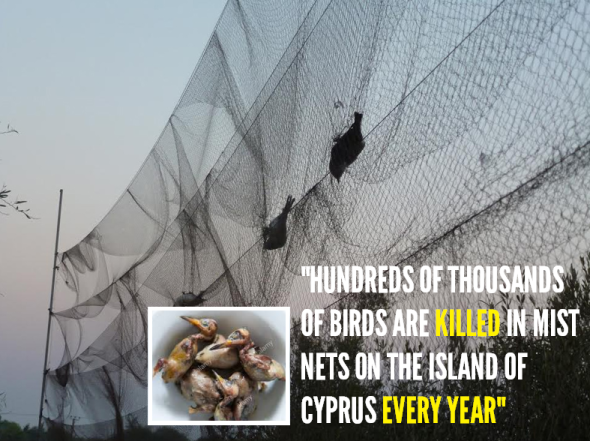
Image: Mist nest. Inset is the local delicacy of Cyprus.
Its estimated (just in Cyprus alone), hundreds of thousands of birds are caught and brutally slaughtered within mist nets every year, and with over a million more using lime sticks - and with laws rarely enforced on the island of Cyprus, will we be seeing a colossal extinction soon of migrating songbirds? I hate to say this, but unless laws are enforced and action is taken against poachers on a larger scale - extinctions will occur.
International Animal Rescue Foundation France has thus far located a total of 139 restaurants on the island of Cyprus, of which we have uncovered out of them 139 some 24 which are selling illegally ambelopoulia. I.A.R.F.F believe that the number of restaurants illegally trading ambelopoulia is much greater than 24. Furthermore due to the dish being so popular and craved after, its highly likely that the ‘majority’ of restaurants are trading ambelopoulia. International Animal Rescue Foundation France are calling on all tourists to please BOYCOTT all Cyprus restaurants that are trading openly this vile and cruel so called delicacy.
The birds sell for approximately CY2.00. One tourist stated: “Consumers are encouraged to swallow the bird whole”. On a plate you’re normally served in between four to five songbirds, and a number of other dishes too. If you are a tourist please, please do not indulge in this delicacy, and report the restaurant immediately to the local police. Another tourist that visited the area of Laxia, stated: “Laxia is somewhat of a favorite with the police, mayor and local mafia. So if there’s anything illegal going on you’ll probably find it there”. From what we are aware locals don’t encourage you to swallow the dead boiled bird[s] whole, however it wouldn’t be somewhat of a shock if this was factual.
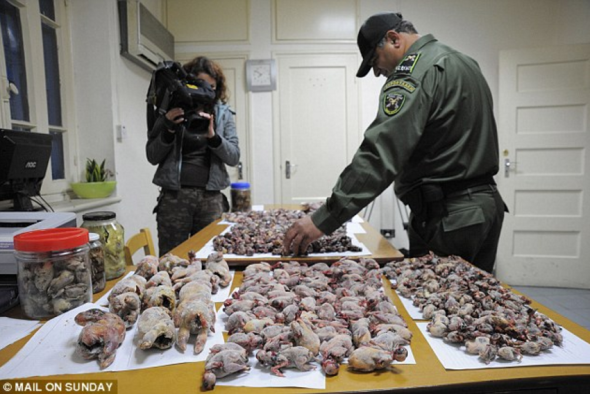
Image: Poached songbirds confiscated from poachers on the UK armed forces base.
“WHY ARE SONG BIRDS IMPORTANT?”
Songbirds are an incredibly important species of bird consisting of over 159 separate species that are endemic mostly to Europe, and as far away as Asia, America, Canada and Africa. While eating them may seem “important or traditional”, scientifically speaking you’re actually harming the environment, and removing yet another food chain link that many other species of animals depend on.
For management purposes, songbirds are part of a group called “land birds,” species that rely mainly on terrestrial habitats and some vegetated wetlands. Songbirds eat a wide variety of foods, including insects, seeds, berries, nectar, and fruit. If we lose our songbirds there will be a dramatic increase of insects, and an alarming decrease in foods that we humans also require.
Furthermore we and other animals need songbirds to continue the spread of plant, fruit and vegetable seeds to ensure that we and animals don’t go hungry. The same applies to fruit trees and bushes too. Many songbirds pollinate fruit trees and bushes - of which them plants and trees provides humans and animals fruits and berries. Finally as explained above - many songbirds are also a vital bird crop pollinator - should extinction occur, then we’ve lost a massive pollinating species that we humans and animals rely on. Are you ready to pollinate crops by hand, or prepared to pay higher prices for fruit and vegetables?
Reptiles, snakes, lizards, and even marine species such as sharks eat songbirds which are part of their diet. No songbirds means a drastic decline of food prey for reptiles, snakes, lizards, marine and amphibious species. So while you may not think songbirds are important - they truly are. Because the trapping methods are non-selective, 150+ species are known to have been caught in the traps. More than a third (58 species) of these are species of conservation concern, including the lesser kestrel, which is vulnerable to global extinction.
Extinction here is really not an option and, we must do more to preserve and secure our songbirds habitat and them too. There are many links and a handful of videos within this article, plus many alarming facts. Please share, and please help us and many other groups defend Mother Natures songbirds. If you see a trap or mist net, please report it. If you can destroy them traps without harm coming to yourself, then please do so. You can even call on us and other groups to destroy these illegal traps too.
“EXTINCTION IS NOT AN OPTION”
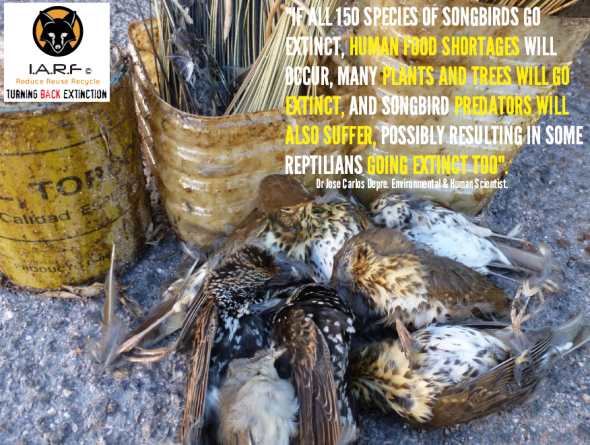
Thank you for reading.
Dr Jose Carlos Depre.
Environmental, Botanical & Human Scientist
PhD. MEnvSc. BSc(Hons) Botany, PhD(NeuroSci) D.V.M.
Endangered Species Friday | Bubalus mindorensis | Asia’s Next Extinction!
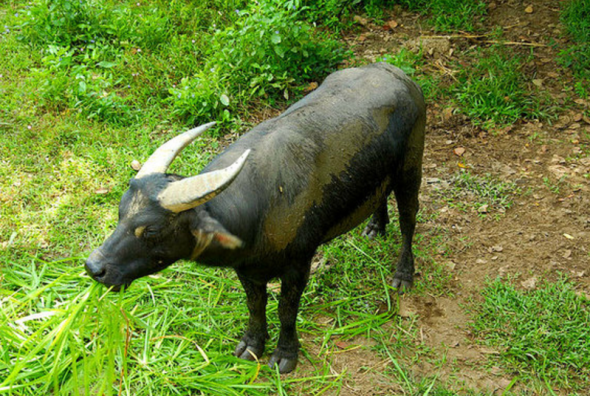
Endangered Species Friday | Bubalus mindorensis
This Friday’s (ESP) Endangered Species Post, I’m touching on a very undocumented species of buffalo that is so endangered - its extremely likely the species will go extinct within the next ten years maximum. (Photographer unidentified).
Listed as (critically endangered) the species was primarily identified back in 1888 by French born Dr Pierre Marie Heude (25 June 1836 – 3 January 1902) whom was a French Jesuit missionary and zoologist. Born at Fougères in the Department of Ille-et-Vilaine, Heude became a Jesuit in 1856 and was ordained to the priesthood in 1867. He went to China in 1868. During the following years, he devoted all his time and energy to the studies of the natural history of Eastern Asia, traveling widely in China and other parts of Eastern Asia.
Endemic to the Philippines B. mindorensis first came to the attention of environmentalists when conservationists began studying the Mindoro Water Buffalo in the early 1940’s of which they found insufficient data relating to the species. Unfortunately from 1986-1996 the species was then suddenly re-listed as (endangered).
Yet the Tamaraw had been known to overseas and native conservation scientists for over THIRTY YEARS of which today we’re now seeing a possible new extinction occurring within the Philippines. How is this possible, when scientists knew about the status of the species, why hasn’t a single zoo removed small populations to house in protective breeding captivity for later reintroduction into the same habitat, or new pastures?
Meanwhile from the year 2000 to 2008 the species was again (re-listed from endangered to critically endangered). Today the Tamaraw is now bordering complete extinction within the wild, and from what we know there is ‘possibly’ no protective captivity projects anywhere around the globe to preserve the species for future reintroduction in the wild. We do hope that we’re wrong?
From what we know based on the last census from 2013 (three years ago) there was noted within the wild only 105 mature individuals remaining. This equates to exactly 105-210 mature individuals (estimate). Within the past three years its very likely we have probably lost half of the remaining populations known, which could mean there is only 52-205 mature individuals remaining within the wild to date.
The species is not known to be fragmented, however populations are still declining. The major threat was once identified as hunting, although ‘allegedly’ isn’t known to be a threat now?. As a scientist and environmental crime CEO I find this very difficult to comprehend, due to the amount of horned ungulates which are being located throughout South East Asia. I must state though: my environmental crimes officers as yet haven’t located any Tamaraw horns or trophy heads.

Image: Tamaraw. Credits: Ruisu Fang.
Formerly, Tamaraw were found across the whole of Mindoro from sea level to the high peaks (to over 1,800 m), inhabiting open grassland or forest glades, thick bamboo-jungle, marshy river valleys, and low to mid-elevation forests. The species is currently confined to a few remote areas over 200 m, and is most often recorded in secondary forest and mixed forest/grassland.
Tamaraw are largely solitary, although females occur with offspring. Males and females occasionally associate temporarily throughout the year, which is similar to other bovines species, such as African buffalo, banteng and gaur. The solitary nature of the species is probably an adaptation to forest habitats, where large groups would prove to be a hindrance. Tamaraw feed primarily on grasses, as well as young bamboo shoots, in open grasslands, resting within tall grasses or dense forest. Although formerly diurnal, Tamaraw have become largely nocturnal due to human encroachment and disturbance.
“WE’RE LOSING THEM, AND FAST”
I do find it quite disheartening to know that the Philippines “national animal symbol” isn’t really being preserved or even protected from nearing complete extinction, although there are some projects out there that are helping to save the species from extinction, the problem is of course, as usual, funding!. One would think that a country that’s so wealthy, and a country that has introduced so many animal, wildlife and environmental laws would at least be fighting to protect the tamaraw. From what I have read and heard from the locals - they are trying their utmost hardest, unfortunately not everyone thinks the same as many kind Filipinos.
THREATS
The main current threat to the Tamaraw is habitat loss due to farming by resettled and local people, with a high human population growth rates in and around its remaining habitat. In some areas, fires set for agriculture are a threat to the species’ habitat. Cattle ranching and farming activities pose a number of threats, including the risk of diseases spreading to the Tamaraw from livestock and burning of pastures leading to a reduced number of palatable grass species.
Historically, Tamaraw were hunted for both subsistence and sport, which led to a period of drastic decline in numbers of individuals and populations. Hunting was carefully regulated prior to World War II, but since then a growing human population, logging operations, ranching, and widespread availability of firearms on Mindoro have caused a dramatic decline in numbers.
Since the 1980s, sport hunting has reduced due to a decline in the Tamaraw population, closure of nearby ranches, and more intensive patrolling and awareness activities since the establishment of the protected area. International trade in this species or its derivatives has not been reported. Although protected by law, the illegal capture and killing of this species continues.
While its currently “illegal to poach or hunt” the species “we believe some are still being poached within the Philippines to provide horns to both China and Viet Nam”. As yet there is NO EVIDENCE to back these claims up, however I.A.R.F.A environmental crimes officers have located in Viet Nam a lot of ‘counterfeit Rhinoceros horn’, which when analysed, has proven to us the horn[s] most certainly aren’t from rhinos, but from a buffalo species. So this area of the counterfeit rhino horn trade still needs intensive investigation.
The current plight of the tamaraw is not looking good, and from our own investigations and third party environmental investigations relating to the species - extinction is very likely to occur in around five to ten years (if that).
“THE TAMARAW IS ASIA’S NEXT EXTINCTION”
Thank you for reading.
Dr Jose Carlos Depre. PhD. MEnvSc. BSc(Hons) Botany, PhD(NeuroSci) D.V.M.
Environmental, Botanical & Human Scientist.
FACEBOOK: IVORY TRADE OFF THE SCALE | VIET NAM | PART I
FACEBOOK | IVORY TRADE IN VIET NAM
Written by Dr Jose C. Depre (Chief Environmental Officer).
By the time it takes me to finish this document an estimated 20-50 elephants will have been slaughtered. Once you turn your head and continue to do nothing, come tomorrow 100 elephants would have been killed for their ivory to supply the South East Asian black market. Back in January 2015 I launched yet another online and ground intelligence gathering operation relating to the illegal wildlife trade; We are focusing on China, Viet Nam, Laos, and Thailand of which the team, a twenty four strong experienced male and female unit originate from all backgrounds. Today I’m focusing more on the online trade which has now increased to worrying new levels.
Since January 2015 when [Operation Stop It] was launched Environmental Crimes Officers have found what we believe is a new trend of ivory trade in operation on the United States platform known as Facebook. External Affairs Officers became aware of the huge trade when investigating a Vietnamese national identified as Mr Trang from June 2015 to December 2015. Unfortunately since providing law enforcement agencies with masses of evidence just on this one trader; very little in the way of arrests and/or confiscations has been witnessed.
The ban on international trade in ivory was introduced in 1989 by CITES (Convention on International Trade in Endangered Species of Wild Fauna and Flora) after years of unprecedented poaching. In the 1980’s, an estimated 100,000 elephants were being killed per year and up to 80% of herds were lost in some regions. However despite the ivory trade ban in place, very little in the way of illegal trade reduction is being witnessed within Viet Nam, China, Laos, and Thailand.
Viet Nam is one country of interest that we’ve noted as hosting “unusually large amounts of (raw ivory tusks), most of which seem to be originating from impounded stocks, with other tusks clearly removed from ivory pyres”. While we are aware a large majority of ivory tusks are originating from Africa, there is also a significantly large amount also originating from Asia. Asian ivory tusks are more favored for carving over that of African elephant tusks.
Image: Two tusks located for sale on Facebook 16.05.16 from | impounded or stolen from pyres?
The two elephant ivory tusks (pictured above) were located on Facebook for sale yesterday which we suspect have originated from a recent or past ivory burn. Normally ivory tusks are white, or a dusty creamy color with some dark tinges to them; embers can clearly be seen on the left hand tusk with visible white dehydration and salt marks too.
Image: Ivory jewelry smuggled from Africa into South East Asia now on sale on Facebook.
While the online trade is no big secret, the fact is Facebook hosts no terms and conditions in place that bans such illegal trade; the Facebook platform has no systems in place to recognize such imagery (I.e raw tusks) using BOTS that can then report back to a third party Policing team. Finally IARFA Environmental Crimes Officers have found Facebook is being exploited by many South East Asian citizens primarily from Viet Nam, and Thailand peddling ivory from Asia and Africa.
Image: Ivory trader weighs up tusks he is trading online via pseudo Facebook account shops.
The image above clearly demonstrates just has serious the ivory trade has become online and on the Facebook social media platform. Traders will commonly show their products to prove their wealth (I.e as a status symbol), or to prove/demonstrate the legitimacy of their products compared to other traders, that may be selling counterfeit ivory. The trader who we can only be name as Mr Phong then demonstrates just how much he will be making come the end of the month. The total amount of ivory Mr Phong is selling on Facebook (pictured above and below) will fetch him around $15,000-$20,000USD depending on how the ivory is sold and/or manufactured.
Image: My Phong weighs up this illegal haul of ivory, fetching him some $15,000-$20,000USD
Despite international and domestic trade bans nothing is actually working, furthermore we do hold concerning evidence that shows without a doubt many tusks are being removed from compounds in Asia and Africa then sold onto the very people that police took the ivory from. Police have been witnessed trading confiscated ivory at high prices back into the hands of smugglers knowing too well they are going to make a good wage due to the high demand for ivory tusk products.
Back in 1992 Viet Nam officially outlawed the ivory trade, unfortunately since the ban was implemented any ivory that was purchased before “Viet Nam’s ivory ban” can still be sold legally so as long as the tusks host the correct certification; Fortunately CITES did rule that “re-worked ivory or any tusks/ivory products that were purchased before or after the 1992 Viet Nam ivory ban that are then re-worked, would then be classed as new ivory (non-exempt) thus making that product that was legal - now illegal.
Meanwhile back in 1975 international trade in “Asian elephant ivory” was also banned. There has been quite a few tusks examined by experts and third party experts located on the United States Facebook platform as originating from Asian elephants. Asian elephant tusks are much smaller than your average African bush elephant tusks. Come the 1980’s it was then stated no fewer than 50,000 Asian elephants existed which are now listed on CITES Appendix One and known to [endangered].
One out of every six Hanoi citizens are dealing ivory on the United States Facebook platform. Most of this ivory is as explained originating from Africa and Asia, with clear and obvious signs of trafficking, and thefts from impounded ivory and ivory pyres.
Image: One of many thousands of online ivory trading Facebook shops in Viet Nam.
The image above was picked up from one of many thousands of Viet Nam ivory traders. Traders establish a sophisticated network of “pseudo Facebook accounts”. These accounts are rarely in the real name of the trader. Traces of some accounts via the IARF Environmental Cyber Crimes Unit have shown ivory traders using Virtual Proxy Networks [VPNs] to conceal their Internet Protocol Address.
Furthermore when dealing over the phone traders normally use cheap (non-smart throw away phones) so that should enforcement agencies locate them, tracing the traders exact whereabouts, and who they are selling ivory onto is almost impossible. Its not uncommon to witness traders with a number of cell phones. One phone (the throw away one) will be used for trade and can easily be disposed of with all evidence destroyed containing names and numbers of ivory dealers and buyers. Meanwhile smugglers, traders and carvers also host a smart phone for normal everyday conversations and general surfing the web or interacting with friends and family on Facebook, Twitter or Weibo.
Back in March of 2016 International Animal Rescue Foundation’s- Environmental Crimes Officers located three Viet Nam ivory trading carving factories all advertised on the United States Facebook platform. Moreover it wasn’t just carvers and ivory advertised for sale; we also located evidence of ivory carving tools, measuring and weighing instruments and “DIY ivory carving instructions for beginners”. The carving instruments below were found in one Hanoi carving workshop (on the Facebook social media platform), meanwhile underneath the bottom image is proof of more raw ivory tusk carving.
Image: Ivory carving tools, Viet Nam, Hanoi used to intricately carve ivory.
Image: In the same carving room more raw ivory tusks were located readied for carving on Facebook.
Environmental Crime Officers have located a staggering 80,000 “ivory and wildlife trade shops” all in operation on the United States Facebook platform, yet little if anything is being done to stop this trade or even restrict traders activities. When submitting this evidence with films, images and Facebook accounts and the current laws on ivory trade to Facebook’s Security Head, Alex Stamos we we’re unfortunately ignored.
Yet Facebook’s moderation team are quite willing to remove accounts that have violated their “bullying, harassment or terrorism polices” (all of which are crimes), sadly the social media platform is unwilling to remove highly active wildlife traders breaking domestic and international wildlife laws that are making a ton daily.
On the 3rd March 2016 the BBC reported “Facebook wildlife trade prompts fears among environmentalists”. Traffic - an Environmental Crimes Investigation Organisation located hundreds of online profiles selling endangered and threatened animal species. Facebook stated “It will not hesitate in removing content that is promoting such trade”. Yet when we contacted Facebook submitting more than enough evidence relating to ivory, rhino horn, tiger and pangolin trade all accounts are still in operation.
Facebook did quote though “They are developing practical solutions to combat trade“, unfortunately these solution’s seem to aimed only at “animals rather than animal parts”. For the time being Facebook has no terms or polices in place that would remove illegal wildlife traders dabbling in rhino horn, tiger parts, pangolins, or [non-exempt] ivory. And with some 1.32+ billion Facebook users, Facebook will we believe now have a large job on their hands in combating such trade as from 2014 trade on the Facebook platform has exploded.
“Investigators are concerned that the use of social media and smartphones means that anyone interested in selling wildlife can rapidly access huge numbers of potential buyers”….
Image: More ivory Facebook shops churning out thousands of euro in ivory, all from raw re-worked tusks.
While Facebook has stated they are developing new measures and applications to combat trade, these new measures and whatever applications will be made to combat trade are all too late. Facebook is probably one of very few platforms where you can actually create “private groups”, where only those that are interested in such trade can enter and interact with other users.
Moreover Facebook provides you secrecy in relation to pages; I.e: Traders can censor which countries they don’t want to view their pages then continue trading whatever they like. In relation to pages there are ways and means around that censorship, which will not be published hereto.
One of the largest items we are seeing traded on Facebook is that of ivory bangles, ivory necklaces, ivory wrist bands, ivory chopsticks, ivory pens, ivory encrusted watches, ivory sex toys and ivory cigarette holders (in the thousands). Overseas tourists that visit Viet Nam are often caught or witnessed buying these small cheap products, and the longer they (the tourist) purchase from ivory carvers and traders, the longer demand will continue to increase and fan out. That is one area of the trade we need all be focusing on (demand) to nip in the bud sooner rather than later.
Ground Sales Survey of Ivory:
Back in 2014, a total of 1614 ground outlets were surveyed in 21 localities throughout Viet Nam. Eighty-five of these outlets (5%) were found to have a total of 2300 ivory items for sale. Buon Me Thuat city was found to have the highest percentage of shops (50%) offering ivory. However since CITES has placed more pressure onto Viet Nam to clamp down on ivory and other wildlife trade, these shops are slowly reducing trade, although we do highly suspect traders are now operating more freely on line from which policing this area of the trade is more difficult.
While it was stated that many shops on the ground had increased somewhat, law enforcement in Viet Nam has allegedly made it more difficult for traders to openly trade ivory that has no exemption. Its is for this reason we now believe Facebook is being used more and more to trade ivory products, and as one can see in the images above - we are talking massive amounts of ivory pieces and products, 90% of which hosts no certification, furthermore the vast majority of traders we’ve located are carving products from “smuggled ivory”.
It is presumed that the currency in which the price is listed or quoted in many ivory surveys may indicate the nationality of the most common buyers in that area. Both observations and questions to particular sellers substantiate the fact that ivory is sold to both “foreign tourists and Vietnamese nationals”. For example in HCMC, the majority of the ivory buyers in the two markets are assumed to be tourists from China as prices were quoted in Chinese Yuan.
Video: Bryan Christy examines the illicit ivory trade. Interesting we have also have located a number of “counterfeit tusks that are being traded online and on the ground”. Please stay tuned for article two that will delve a little deeper into both the counterfeit rhino horn, ivory and tiger part trade.
The HCMC silver and gold shops that also offered ivory (particularly the smaller, religious pendants and figurines) appear to be targeting Vietnamese buyers with prices advertised in VND. In Dak Lak and Ha Tien, the majority of the ivory buyers are assumed to be Vietnamese tourists as prices there were quoted in VND. In Ha Noi, prices were mostly given in USD when enquiries were made, which may indicate that the buyers of ivory pieces are likely to be international tourists.
While the majority of ivory is presumed to be aimed at mostly Asian tourists - there is no real hard hitting evidence that this is in deed true. For example if you was British you’re hardly going to purchase an ivory bangle in GBP, so exchanging that currency into Vietnamese dollars then places that ivory for sale (at just about everyone and anyone) with the correct currency.
It may be somewhat of a shock but the UK is the third biggest source of intercepted illegal ivory entering the United States of America (US), which has been singled out by CITES (the Convention on International Trade in Endangered Species of Wild Fauna and Flora) as a ‘problem country’ with a large domestic ivory trade likely to provoke illegal elephant poaching if not regulated and brought under control. London’s Portobello Road – the biggest antiques market in the world – has been identified as the single major source of this illegal ivory.
Furthermore while antique ivory trade is “problematic” so too is non-antique and the longer these trades persist, more and more elephants will be slaughtered for their tusks. We are growing very concerned now at the large number of ivory dealers operating on Facebook. There is clear evidence that much of this ivory is originating from both Africa and Asia, furthermore as explained - the large number of “raw tusks we are locating clearly shows that security is indeed more than questionable at ports, and pounds that hold confiscated ivory.
Image: Raw African ivory tusks, cut and sold onto Viet Nam carvers, on sale on Facebook.
Back in 2015 (just before Christmas) External Affairs Environmental Crimes Officers located an “unusual amount of raw tusks from Africa” that we suspect had made their way into Viet Nam from China. IARFEIA Officers located on the Facebook platform some 21 whole raw and non-certified elephant tusks, some of them even had blood around the bases indicating these were freshly poached ivory tusks; all of which is in violation of both domestic and international ivory trade laws.
Image: Vietnamese ivory carver aged 19 from Hanoi, Viet Nam.
The image above doesn’t really show much does it? although the other images below shows exactly what this talented young man has been creating from raw African and Asian elephant tusks (and is still creating today with his freinds - all college students). Ivory traders and dealers make no attempt at concealing their identity anymore neither. However there still remains a hardcore number of dealers that will continue to conceal their faces, names, and never post images onto Facebook that depicts them holding raw non-exempt ivory. This belief that ivory traders, peddlers, and smugglers were all but old, is now a myth. Today we’re witnessing traders and carvers as young as 16 years old, taking over from their parents thus fueling the ivory trade evermore on Facebook.
Image: Young trader named as Mr Manh exhibits his newly carved ivory pieces on Facebook.
Image:Mr Manh proudly shows one of many hundreds of ivory pens that are in great demand.
Image: Ivory pen with top off, Viet Nam, Hanoi.
Image: Ivory trader identified as Mr Trang proudly displays carved ivory on Facebook for sale.
Image: More freshly carved ivory cartridge pens on sale in Hanoi, via Facebook.
From 2015 (to date) IARFA Environmental Cyber Crimes Officers and the ground team External Affairs Environmental Crimes Officers have found that Viet Nam is “suspected” of peddling more ivory than China and Thailand. Cyber Crimes Officers are now locating every week on average of 2-3 “raw tusk dealers” operating on Facebook. Meanwhile the database of 80,000 ivory and wildlife trade dealers all operating on Facebook continues to increase by the week.
The whole purpose of this article is to wake people up, and open their eyes. We have a major problem on Facebook, and Alex Stamos Facebook Head Security Officer doesn’t seem to be taking much notice of this ongoing and rather concerning problem relating to just the ivory trade alone. We’ve not got much time left, there is an estimated 50,000 Asian elephants in Asia, and “known - some 600,000 African elephants remaining on the continent of Africa with a probable 1.2 million known but (uncounted).
Facebook has become a hotbed for the lucrative and illicit most illegal wildlife trade. And for the time being not a single thing is being done to control this trade. Please sign the petition hereto: http://www.thepetitionsite.com/645/521/701/facebook-remove-illegal-pet-and-wildlife-traders-from-your-server/
“The Extinction Clock is Ticking”
Thank you for reading.
Chief Environmental Officer, Dr Jose C. Depre.
Environmental Crimes Department.
Endangered Species Friday: Amazona versicolor
Endangered Species Friday: Amazona versicolor
This Fridays Endangered Species Post (ESP) I touch up briefly on the St Lucia Amazon as the species is commonly known. Image credits Philippe Feldman
The species was identified back in 1776 by Dr Philipp Ludwig Statius Müller (April 25, 1725 – January 5, 1776) who was a German zoologist. Dr Statius Müller was born in Esens, and was a professor of natural science at Erlangen. Between 1773 and 1776, he published a German translation of Linnaeus’s Natursystem.
The supplement in 1776 contained the first scientific classification for a number of species, including the dugong, guanaco, potto, tricolored heron, umbrella cockatoo, red-vented cockatoo, and the enigmatic hoatzin.
Dr Muller was also an entomologist. Müller died in Erlangen. He is not to be confused with Salomon Müller (1804–1864), also an ornithologist, or with Otto Friedrich Müller. Note that the family name is actually spelled without the umlaut, then and now.
The Saint Lucia Amazon is listed as (vulnerable) which was nearing (endangered), native to Saint Lucia. From 1988 the species was first listed as (near threatened), however, unfortunately from 1994-2016 the species was re-listed as (vulnerable). Locals commonly refer to the species as the; Saint Lucia Amazon, or the Saint Lucia Parrot.
Populations are considered to be extremely low, although now allegedly increasing. A decade ago the then current known population rate stood at some 350-500 individuals, this generally equates to some 230-330 ‘mature individuals’. This number was actually considered quite low for any species which technically should see the St Lucia listed as (critically endangered).
St Lucia Amazon Parrot is situated on the island of St Lucia in the eastern Caribbean where it is known locally as ‘Jacquot’. The Government of the island became aware of the plight of its endemic parrot population in 1975 when Durrell first became involved with St Lucia, and the Trust was asked to help by starting a captive breeding programme for the species at its Jersey headquarters. In 1989 a pair of captive-bred parrots returned to their native home with the Prime Minister of St Lucia.
The St Lucia Amazon’s natural habitat is subtropical or tropical moist montane forest, diet consists of fruit and insects, of which clutch size is around 3-4 eggs. The species is threatened by habitat loss. St Lucia Amazon species have declined from around 1000 birds in the 1950s to 150 birds in the late 1970s. At that point a conservation program began to save the species, which galvanized popular support to save the species, and by 1990 the species had increased to 350 birds.
Although the population in Saint Lucia is small it is still expanding. To date after conservation efforts increased on the island of St Lucia due to destructive storms and hurricanes populations were increased to some 2,100 mature individuals. Please see video below.
The story of this birds salvation from the brink of extinction (including the influence of conservationist Paul Butler) is told in Chapter 7 of the 2010 book “Switch: How to Change Things When Change is Hard” by Chip & Dan Heath.
Listed on Cites Appendix I and II, below I’ve included a list of identified threats associated with the St Lucia Amazon Parrot.
MAJOR THREATS
The human population of St Lucia is growing at a considerable rate, increasing pressure on the forest and resulting in habitat loss. Selective logging of mature trees may significantly reduce breeding sites, and hurricanes, hunting and trade pose further threats. There have been recent efforts to lift the moratorium on hunting within forest reserves, which would seriously threaten this species.
Image: St Lucia Amazon
Its truly wonderful to know that conservation efforts have brought this species back from the brink of near extinction. The Durrell Wildlife Conservation Trust is one trust that I admire, and have donated many hundreds of euros to since I was a teenager. Durrell have worked wonders across the globe working to help primates, frogs and countless birds, not forgetting many other animals..
The Durrell Wildlife Conservation Trust is one NGO that I myself will be leaving money to in my will. Why? Because they deserve the money for the work they put into preserving our flora and fauna. You can donate to the Durrell Wildlife Conservation Trust here: https://www.durrell.org/wildlife/shop/donation/
Thank you for reading and have a nice day.
Dr Jose C. Depre PhD. MEnvSc. BSc(Hons) Botany, PhD(NeuroSci) D.V.M.
Chief Environmental and Botanical Scientist.
Follow me on Twitter here: https://twitter.com/josedepre11
Facebook: https://www.facebook.com/InternationalAnimalRescueFoundationAfrica/?fref=ts
Endangered Species Friday: Dendrolagus dorianus | Cuddly Teddy Bear Facing Extinction.
Endangered Species Friday: Dendrolagus dorianus
This Friday’s (Endangered Species Post) [E.S.P] I touch up on this rather unusual species of tree kangaroo that’s rarely mentioned within the world of conservationism. Furthermore I also wish to set the record straight about these wonderful and utterly adorable species of mammals which many people seem to believe are endemic ‘just to Australia’. This particular species is actually native to Papua New Guinea, generically identified as Dendrolagus dorianus. (Image credits: Daniel Heuclin).
Listed as (vulnerable), the species was primarily identified by Dr Edward Pierson Ramsay (3 December 1842 – 16 December 1916). Dr Ramsay was an Australian zoologist who specialized in ornithology. Among organisms Dr Ramsay named are the pig-nosed turtle, giant bandicoot, grey-headed robin and Papuan king parrot.
D. dorianus lives within a country of immense cultural and biological diversity. A country known for its beaches, coral reefs and scuba diving. Not forgetting the countries inland active volcanoes. Locals commonly identify the animal as the; Doria’s tree kangaroo or the unicolored tree kangaroo. Doria’s tree kangaroo is within the order of Diprotodontia, and the family identified as Macropodidae.
Since 1982 to 1994 the species has remained at [vulnerable level] of which back in 1996 a further assessment of the species noted a possible population decline. The decline prompted environmentalists to notch the species further up the list of [vulnerable species]. However a survey in 2008 concluded the species hadn’t as yet qualified for any further threatened status (E.g) endangered (which would unfortunately be the next listing should threats not decline in the wild).
Scientific research and population evaluations have shown a staggering 30% decline of overall wild populations which is quite a large population decrease, although “allegedly not concerning enough as yet to reclassify this particular specimen as endangered”. Yes its unfortunate that the current news relating to (decreasing populations), is indeed factual, and its likely (as explained), that should threats in the wild not decrease anytime soon, we could see a new extinction occurring in as little as ten years “if not sooner”. Populations are not known to be ‘fragmented’.
Image: Rare glimpse of the Doria Tree Kangaroo.
Identified in 1883 there are very few conservation actions actually known that could help increase declining population sizes which I myself find somewhat frustrating, not to mention perplexing, especially when one takes into consideration the current level of threats associated with this specie in Papua New Guinea.
Research proves the species inhabits some several protected national parks [NP’s], unfortunately extreme hunting activities I.e illegal poaching is still ongoing. While Anti Poaching Operations [APU’s] do exist, the fact of the matter is that Cites (The Convention on International Trade of Endangered Species Wild Flora and Fauna), still hasn’t listed the species as (protected or endangered) on either Appendix I or Appendix II.
Image: Extinction may occur in a decade of not sooner.
To date the current population level is unknown, furthermore reproduction is also believed to be incredibly low and poor.
MAJOR THREATS
Known threats relate to the bush meat trade, which if not controlled will unfortunately push the species into extinction. Hunting with dogs, unregulated/illegal hunting is quite high and problematic within the region. Finally the species absolutely hates canines of which when threatened emits depressed vocalizations. Future threats have been identified as habitat loss and degradation.
The Doria’s tree kangaroo lives at elevations of some 600-3,650 meters of which is mostly nocturnal and a solitary animal. Dr Ramsay named the species after Professor Marquis Giacomo Doria (1 November 1840 – 19 September 1913) whom was an Italian naturalist, botanist, herpetologist, and politician of Italy.
Doria’s tree kangaroo is probably one of the largest species of tree kangaroos on the planet, although this is somewhat debatable. Weighing in at 6.5-14.5 kilograms, length is around 60-80 centimeters, with a tail length of some 40-70 centimeters. With a large tail, dense black and brown fur, large powerful claws and stocky build, the appearance of this specific animal almost appears to look like a medium sized bear.
Diet consists of leaves, flowers, fruits and buds, there is no evidence that suggests or points to any form of meat eating either. Gestation period of females is around thirty days, of which the ‘single young baby’ will remain in mothers pouch for around ten months.
There really is limited information about this specific species which could be due to the fact the species is actually very rare, nocturnal, and lives at moderate to high elevations within dense montane forests. I am asking the public to please share this article far and wide to help us push more awareness of this species into the public domain, which we hope will encourage (Cites) to protect the species sooner rather than later.
This article is dedicated to Ms Toni Devine, a wonderful young lady that absolutely adores these wonderful species of animals, who wouldn’t adore them, they are truly remarkable, intelligent, and in way more like cuddly teddy bears.
Chief Environmental & Botanical Officer
Dr Jose C. Depre
Environmental Crimes Investigator
Follow me on Twitter here: https://twitter.com/josedepre11
Follow us on Facebook via clicking the link below:
https://www.facebook.com/InternationalAnimalRescueFoundationAfrica/
Endangered Species Monday: Tremarctos ornatus
Endangered Species Monday: Tremarctos ornatus
This January’s (2016) Endangered Species Watch Post is dedicated to the Tremarctos ornatus, commonly known as the Andean Bear or Spectacled Bear. The species was identified by Dr Jean Léopold Nicolas Frédéric Cuvier back in 1825. Dr Jean Léopold Nicolas Frédéric Cuvier lived from (23 August 1769 – 13 May 1832), known as Georges Cuvier, was a French naturalist and zoologist, sometimes referred to as the “Father of paleontology”. Cuvier was a major figure in natural sciences research in the early 19th century and was instrumental in establishing the fields of comparative anatomy and paleontology through his work in comparing living animals with fossils.
From 1982 to 1996 the Andean Bear has been listed as (vulnerable), of which its main threats are habitat loss and major poaching for the animal parts trade. Within the past thirty years populations have declined by a staggering 30% which qualifies the bear as being listed as (vulnerable). Habitat loss continues at a rate of 2-4% per year, which as yet doesn’t look set to decline. Furthermore identified threats do not look set to decrease anytime soon which could see this stunning animal pushed into extinction very soon.
Poaching is one of the main problems that can be controlled if (anti poaching enforcement) is increased within the bears habitat, unfortunately this is easier said than done. Furthermore, continued habitat destruction and illegal logging will see forest tracks opened up within the bears natural habitat, thus allowing poachers to walk freely into the bears home environment, thus seeing poaching occur. Anti poaching enforcement is a must, and needs to be taken seriously by all international (non-governmental organisations) that are working to sustain this animals welfare, and habitat.
Endemic to Bolivia, Colombia; Ecuador; Peru, and Venezuela, populations of the Andean Bear are now known to be decreasing rapidly, however populations are not reported to be (fragmented). Back in 1998 it was estimated by Dr Peyton that there was a mere 20,000 Andean Bears remaining. A 2003 survey, however estimated that there was in between 5,000 to 30,000 Andean Bears remaining. Andean Bears are now commonly located within the eastern Andes of which bear populations exist from the snowline down to 300 m asl in the Tapo-Caparo National Park in Venezuela. Andean Bears can also be located at high altitudes in Ecuador, Peru, Bolivia, and Columbia.
Andean Bears are “omnivores”, meaning that they feed exclusively on plant matter, fruits, bark and occasionally will consume meat of other animals, the bears preferred diet though is reported to be species of flora from the Bromeliaceae and Arecaceae. Activity patterns range from strictly diurnal for wild bears in Bolivia to mixed diurnal and nocturnal for reintroduced bears in Ecuador.
“EXTINCTION BY 2030 IS POSSIBLE”
As food is available year-round in all parts of their range, Andean bears do not hibernate. Based on the first few individuals of this species to be monitored using ground telemetry in Bolivia and Ecuador, home ranges overlap to a high degree and minimum home range sizes vary from 10 to 160 km² (although these are underestimates, as the bears were regularly out of range of radiotelemetry in both studies).
The Andean Bear stands at around 5ft to 6ft tall, and weighs in at around 220, 330lbs. The markings on the Andean bear’s face, neck and chest are exactly like human finger prints (unique to each and every individual Andean Bear). Andean bears are very timid and shy and prefer to live in isolated cloud forests, of which they are “mainly nocturnal” however will at times feed, live and socialize in daylight (although this is considered rare). Favorite foods are cacti, berries and of course honey.
Andean bears are quite typically solitary animals, and will only be seen in pairs during mating season. Females normally give birth to (1-2 cubs), cubs are normally mobile after one month, however will remain with their “mother” for up to eight months, mothers will often be seen with little cub hitching a ride on the back on the mothers back. Population studies state today that there may be no fewer than 3,000 Andean bears in the wild., which if true could soon see the species nearing extinction by 2030.
ANDEAN BEAR THREATS
Habitat loss and fragmentation, poaching, and the lack of knowledge about the distribution and status of the Andean Bear are the principal threats to this species. Much of the range of the Andean Bear has been fragmented by human activities, largely resulting from the expansion of the agricultural frontier. In some areas, mining, road development and oil exploitation are becoming a greater menace to Andean Bear populations as well as to local communities, due to land expropriation, loss of habitat connectivity, and water and soil contamination.
Many Andean Bear populations are isolated in small to medium-sized patches of intact habitat, particularly in the northern part of the range. The situation tends to improve towards the southern range, with some large patches of wilderness still remaining. Nevertheless, human population growth and national development plans throughout the Tropical Andes continue to be an important cause of habitat fragmentation and to threaten the connectivity among remaining wilderness patches.
Poaching is a serious threat throughout the Andean Bear range. Bears are often killed after damaging crops, particularly maize, or after purportedly killing livestock. Also, Andean Bear products are used for medicinal or ritual purposes and at some localities Andean Bear meat is highly prized. Live bears are also sometimes captured and sold.
Human induced mortality endangers the viability of small remnant populations. Lack of knowledge about the distribution and status is a problem throughout the region. In many areas, information about the status of Andean bears is outdated or, particularly in the southern portion of the range, simply non-existent. The absence of knowledge makes it difficult to develop realistic management plans for the conservation of this species, or to monitor changes in its distribution (reflective of changes in population status).
It is without a doubt the Andean Bear is facing “imminent extinction”, and from studies that are being conducted by various organisations including the International Animal Rescue Foundation Brazil, its very likely this animal is going to be pushed into extinction very soon.
Thank you for reasding the first part of this years (2016) Endangered Species Watch Post, and please feel free to scroll through 2014-2015’s posts below via the automatic scroll new feed bar.
Dr Jose C. Depre PhD. MEnvSc. BSc(Hons) Botany, PhD(NeuroSci) D.V.M. Environmental & Human Science
Chief Environmental Officer and Director
Donate today and help us continue our worldwide anti-wildlife trade enforcement operation continuing. Please click the DONATE button below.
Endangered Species Monday: Rhinoceros sondaicus
Endangered Species Monday: Rhinoceros sondaicus
This Endangered Species Post (ESP) Monday I have decided to touch up on the current fate of the critically endangered Javan Rhinoceros of which scientists this month caught yet another rare glimpse of this rather elusive beast within their still natural habitat. (Pic Javan Rhinoceros)
The Javan Rhinoceros was identified back in 1822 by Dr Anselme Gaëtan Desmarest (March 6, 1784 – June 4, 1838) was a French zoologist and author. He was the son of Nicolas Desmarest and father of Anselme Sébastien Léon Desmarest. Desmarest was a disciple of Georges Cuvier and Alexandre Brongniart, and in 1815, he succeeded Pierre André Latreille to the professorship of zoology at the École nationale vétérinaire d’Alfort. In 1820 he was elected to the Académie Nationale de Médecine.
Unlike the African black and white rhino, you’d be very lucky to catch a glimpse of this stunning specimen of which is classified as a sub-species of the four extant Rhinoceros and, is nearing complete extinction within the wild. Furthermore the subspecies of the Javan Rhinoceros are all extinct too. Known as Rhinoceros sondaicus sondaicus, Rhinoceros sondaicus annamiticus, and Rhinoceros sondaicus inermis the three sub-species went extinct from 1930-2011. Below I have included the “documented dates” of extinctions for the three sub-species to the Javan Rhinoceros.
- Rhinoceros sondaicus sondaicus (extinction was formally documented from 1999, however this report needs to be backed up with further historical data to pinpoint an exact extinction and location).
- Rhinoceros sondaicus annamiticus (extinction was formally recorded in 2010, however reports state the very last male was located dead within Viet Nam back in 2011).
- Rhinoceros sondaicus inermis (extinction was formally recorded back in 1925).
Please note the Wikipedia article online has confused the (extanct) R. sondaicus with the (extinct) subspecies Rhinoceros sondaicus sondaicus.
From 1965 Rhinoceros sondaicus was considered ‘extremely rare’ within the wild, then from 1986 to 1994 the species was classified as (endangered). Unfortunately from 1996 the species was again re-classified as (critically endangered) and now no fewer than sixty individuals remain within the wild. The last sighting of ‘a’ Javan rhino was I believe on the 18th September 2015 at exactly 17:46 hrs within the Ujung Kulon National Park.
Javan rhino’s did cover quite an extensive area ranging from Bangladesh, Myanmar, Thailand, Lao PDR, Cambodia, Viet Nam, and probably southern China through peninsular Malaya to Sumatra and Java. Sadly the species is now thought to be inhabiting the Ujung Kulon National Park which is located within Indonesia. Further non-viable (all male) and elderly populations are also claimed to be inhabiting a very small area of Viet Nam.
To date the species is now endemic only to Indonesia, however there are said to be few individuals ‘possibly’ remaining within Viet Nam too. I must stress though that there has been no official camera trap sightings or actual eyeball sightings of the species in as many years within Viet Nam of which its likely the species “may have gone extinct”.
Regional extinctions of the current sub-species have occurred within the following countries; Bangladesh; Cambodia; China; India; Lao People’s Democratic Republic; Malaysia (Peninsular Malaysia); Myanmar and Thailand. Reports from the 18th September 2015 have also confirmed that the species has taken some ‘fifty years’ to double in size from (50) to now (60) individuals remaining.
From the middle of the nineteenth century the species was practically eradicated due to over-hunting, unregulated hunting, poaching, disease and habitat destruction. The last records of the Javan Rhinoceros within locations not listed above were from 1920 in Myanmar, to 1932 in Malaysia, and 1959 on Sumatra (Indonesia). Up to date records have proven further sightings this year and last year within Indonesia’s Ujung Kulon National Park. The last “known” poached Javan Rhino (sub-species) was said to be from 2010-2011 which was that of the Rhinoceros sondaicus annamiticus species of which “complete extinction” was formally documented in relation to this specific sub-species of the Rhinoceros sondaicus.
The exact number of individuals noted within the wild is said to be in between 40-60 individuals however due to such small “fragmented locations” its quite difficult at times to know just how many do actually remain, hence the need for increased conservation projects, funding and anti poaching operations to increase. On a good note we know the species is reproducing, unfortunately on a bad note 40-60 individuals is considered near extinct and drastic measures need to be implemented sooner rather than later to preserve the remaining wild specimens.
The second “alleged” location and I stress alleged of the Rhinoceros sondaicus occurs in and around the Cat Loc part (Dong Nai province) of the Cat Tien National Park in Viet Nam, with maybe as few as six individuals remaining. Please do remember not to confuse the extinction of the Rhinoceros sondaicus annamiticus within the same country (Viet Nam) with the Rhinoceros sondaicus that’s considered still extant although possibly believed to be extinct within (Viet Nam). (I will be providing an update in relation to the alleged Cat Tien Javan Rhino R. sondaicus) via my main Facebook site and will correct amend this document accordingly.
Something I do find rather peculiar is that there are currently no Javan Rhinoceros within protective captivity. Records have stated that some twenty two individuals have been recorded within protective captivity though. I do find this rather strange as we have in zoological gardens around the world just about every other species of Rhinoceros to protect its current future for reintroduction back into the wild at a later date - yet the Javan Rhinoceros has literally been left to its own demise. I’ve yet to locate any real reasonable explanation as to why from the mid 1980’s some individuals were not removed from the wild and bred within protective captivity.
Image: Javan Rhinoceros information graph.
The Javan Rhinoceros currently occurs in lowland tropical rainforest areas, especially in the vicinity of water. The species formerly occurred in more open mixed forest and grassland and on high mountains. Because of its rarity, little is known about its preferred habitat, but it is certainly not naturally restricted to dense tropical forest water. Little is known about the species’ biology and the habitats in which the two remaining populations are found may not be optimal.
The home range size of females is probably no more than 500 ha, while males wonder over larger areas, with likely limited dispersal distance. The species is generally solitary, except for mating pairs and mothers with young. Its life history characteristics are not well known, with longevity estimated at about 30-40 years, gestation length of approximately 16 months (as with other rhino species), and age at sexual maturity estimated at 5-7 years for females and 10 years for males. -IUCN.
Unlike their African relatives the Javan Rhinoceros has a rather small single black horn (typical of Asiatic rhinos). The black market for rhino horns varies with species and price of current horn however it must be noted that the “rarer” the species the more value the horn will provide to the seller. Your average African Rhinoceros horn fetches in the region of $60,000 to $80,000 per kilogram on the black market. However the Asiatic Rhinoceros horn[s] can fetch over or even double this should the species be considered extremely rare.
On a recent visit to Viet Nam I was viewing more Asiatic antique Rhinoceros horn on the black market still selling at higher prices than African rhino horns, however not once did I locate any fresh African horns (2014). So again the need to drastically increase conservation actions, funding and anti poaching patrols is greatly needed. In my own opinion there seems to be way too much funding and awareness pushed into Africa with little progress being seen. Whereas in relation to the Asian Rhinoceros, funding and awareness identical to whats being witnessed in Africa is not even a fraction seen within Asia.
Threats
The cause of population decline is mainly attributable to the excessive demand for rhino horn and other products for Chinese and allied medicine systems. The bulk of the remaining population occurs as a single population within a national park and the population size in Ujung Kulon National Park is probably limited to the effective carrying capacity of the area (around 50 animals). One possible threat to this population is disease. In addition, such a small population faces a constant threat from poachers, although there is evidence that current poaching levels are under control. The Cat Loc population may be too small to be viable, and no breeding has been observed for many years, and it is possible that the animals are too old to breed. The population is so small that all the animals could be of the same sex.
While we have in the past month witnessed new Javan sightings and evidence of reproduction the Javan Rhino is by far nowhere near from danger. As explained above disease could wipe the entire fifty to sixty remaining individuals out. Furthermore while poaching levels are currently under control - it will only take a single individual or group of poachers to gather intelligence on the remaining populations thus exterminating the entire wild populations indefinitely.
My name is Dr Jose C. Depre, thank you reading and please be most kind to share and make aware the current plight of our Asiatic Rhinoceros.
Dr Jose C. Depre
Environmental and Botanical Scientist.
NB: Please note that while there have been “reported sightings” of the R. sondaicus in Viet Nam there is no up to date data that proves this species is still endemic to the country of Viet Nam.

